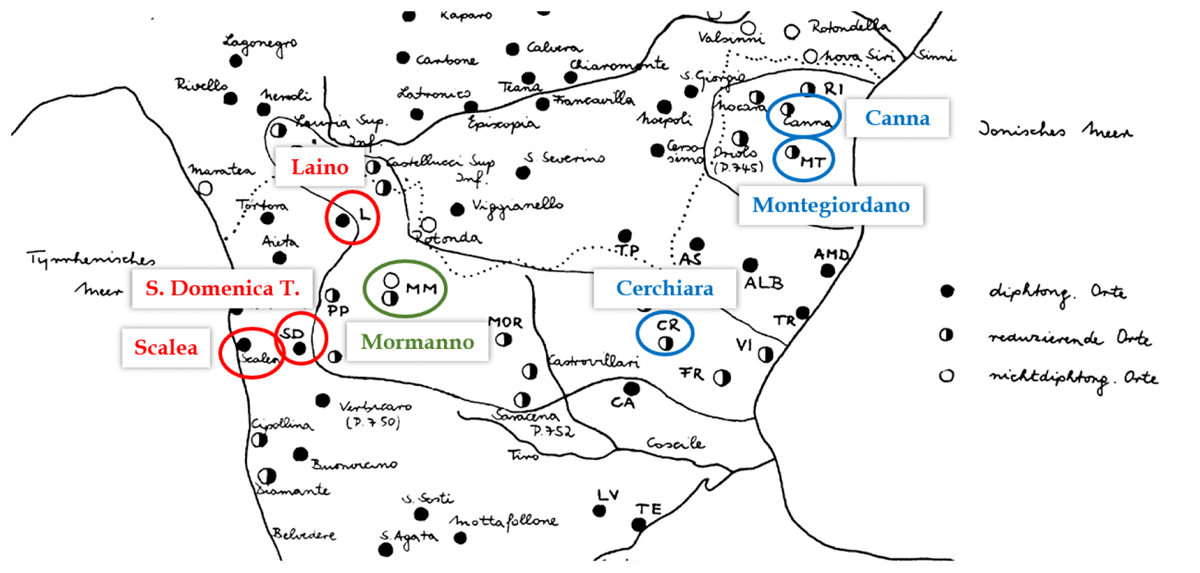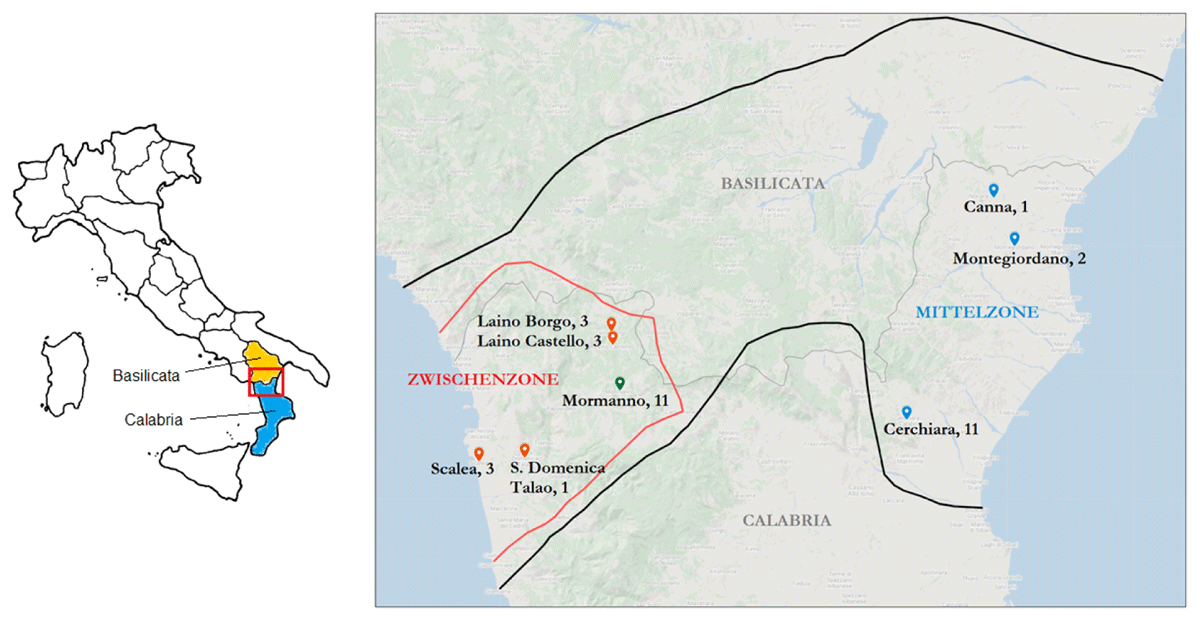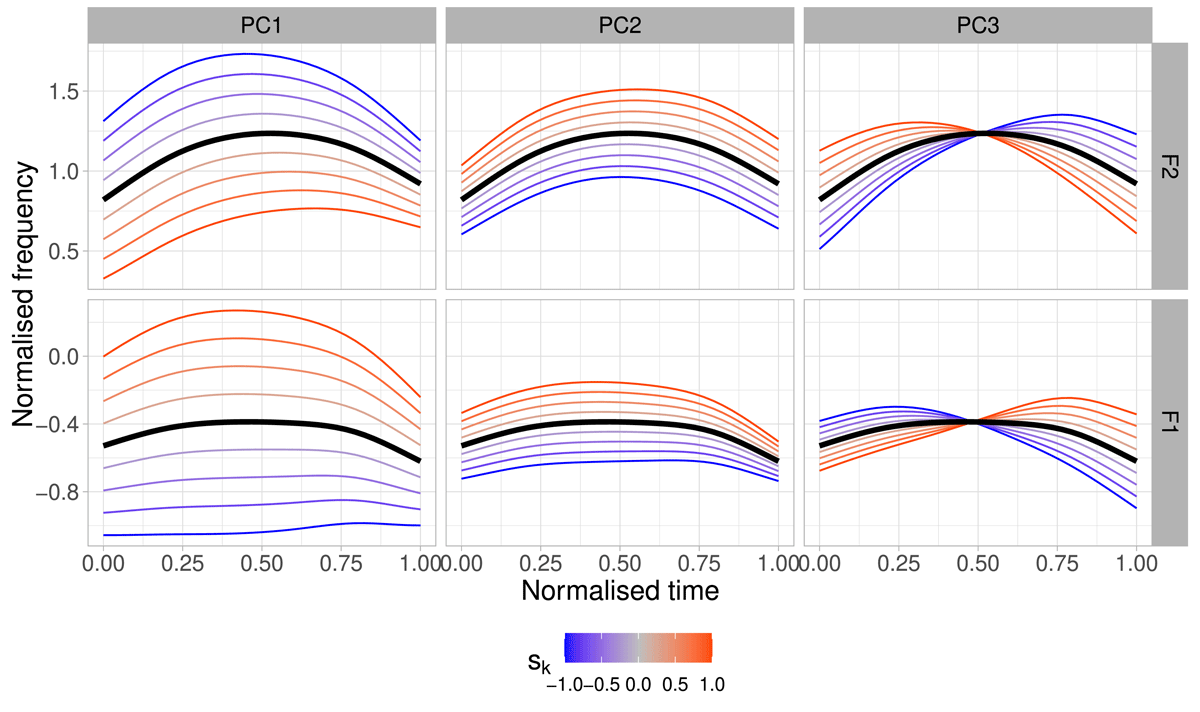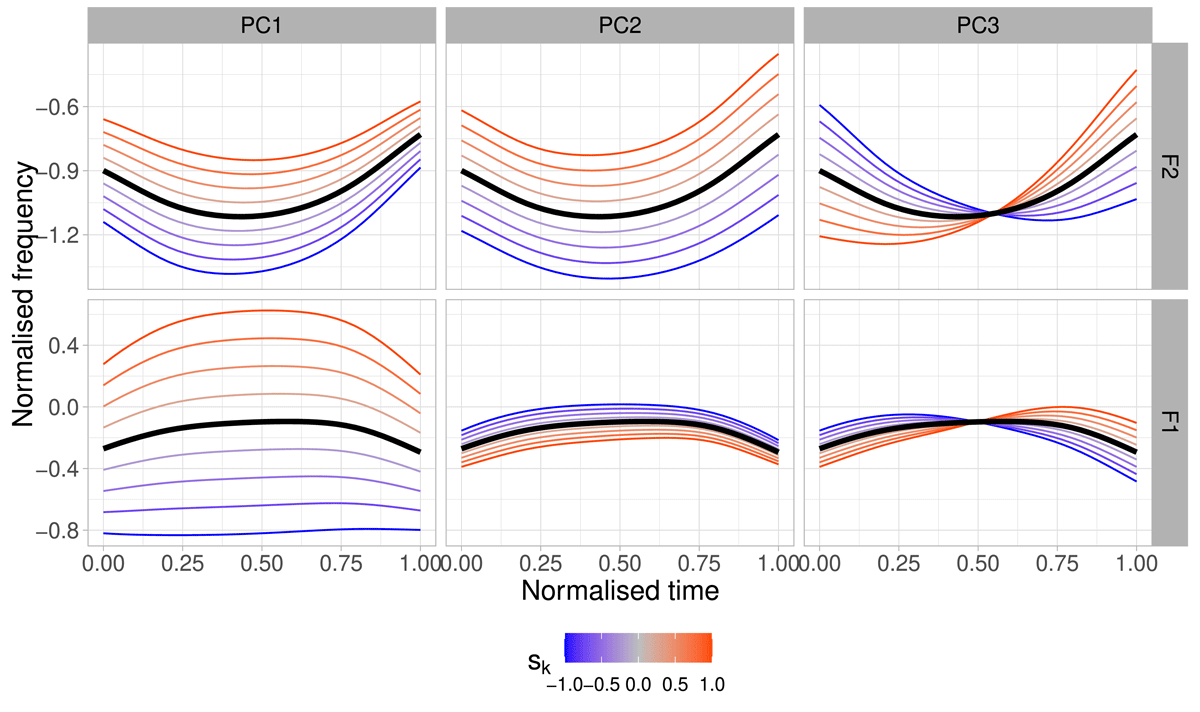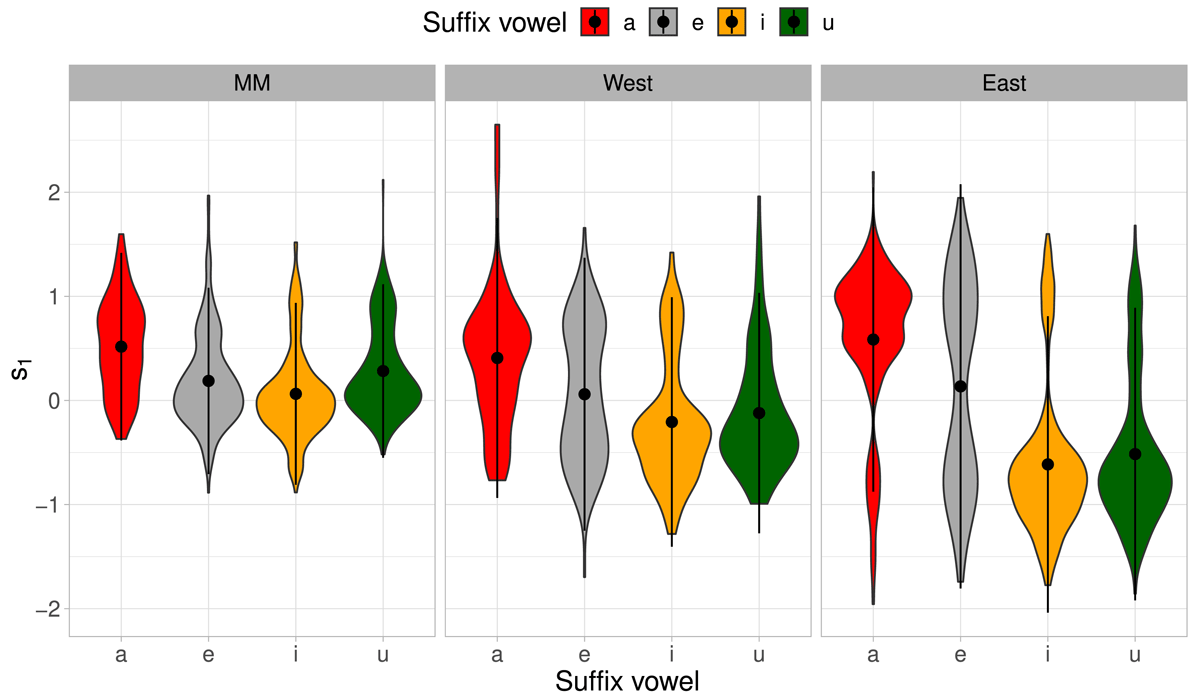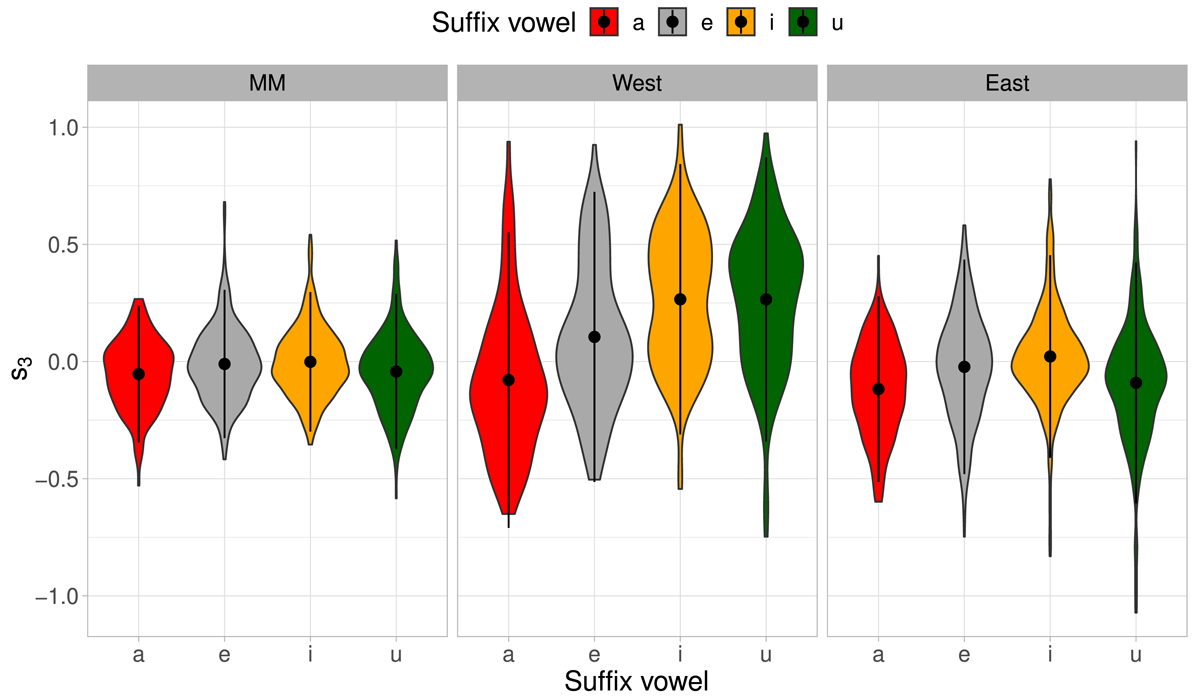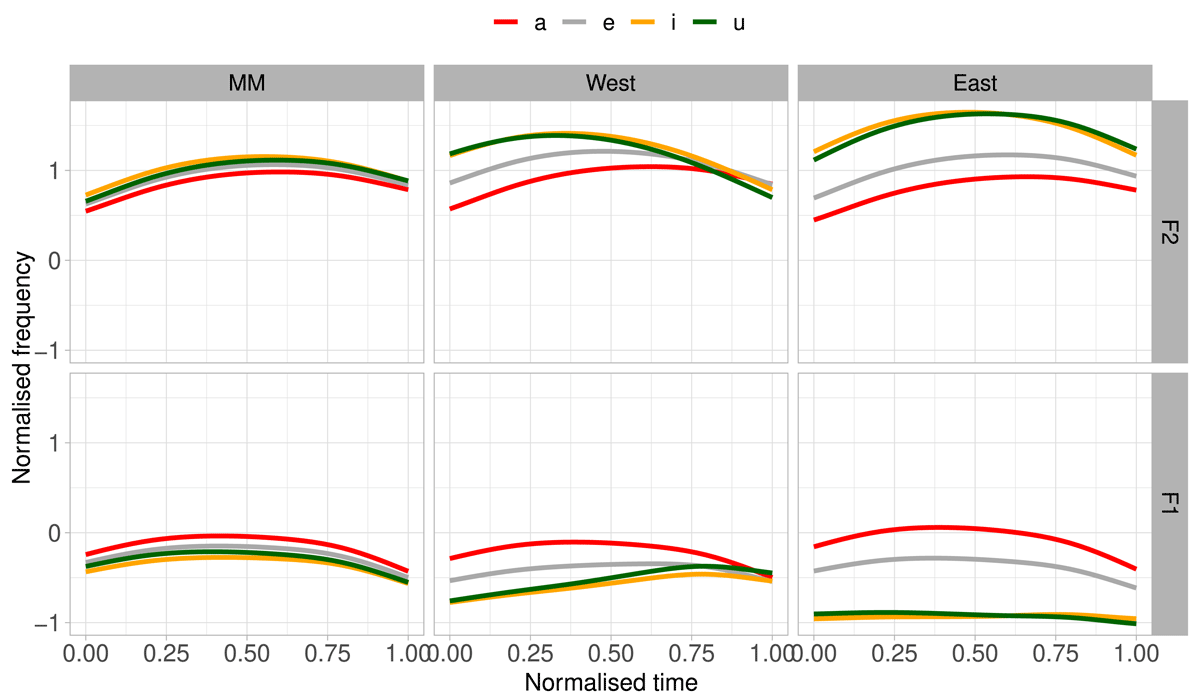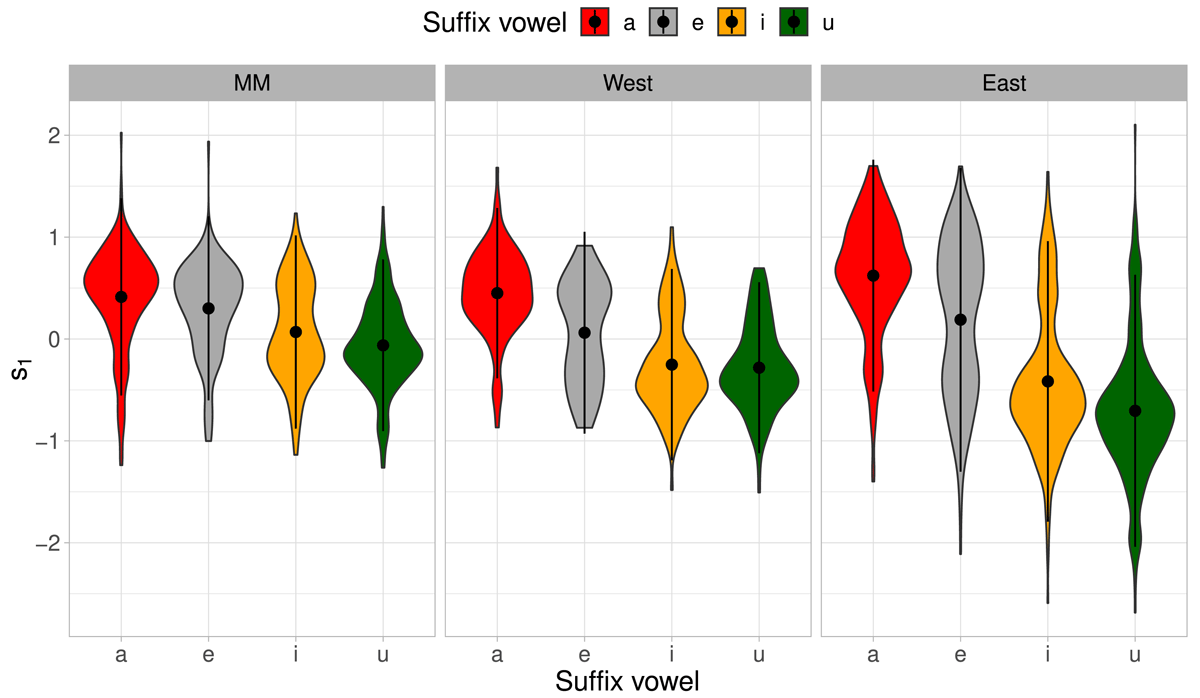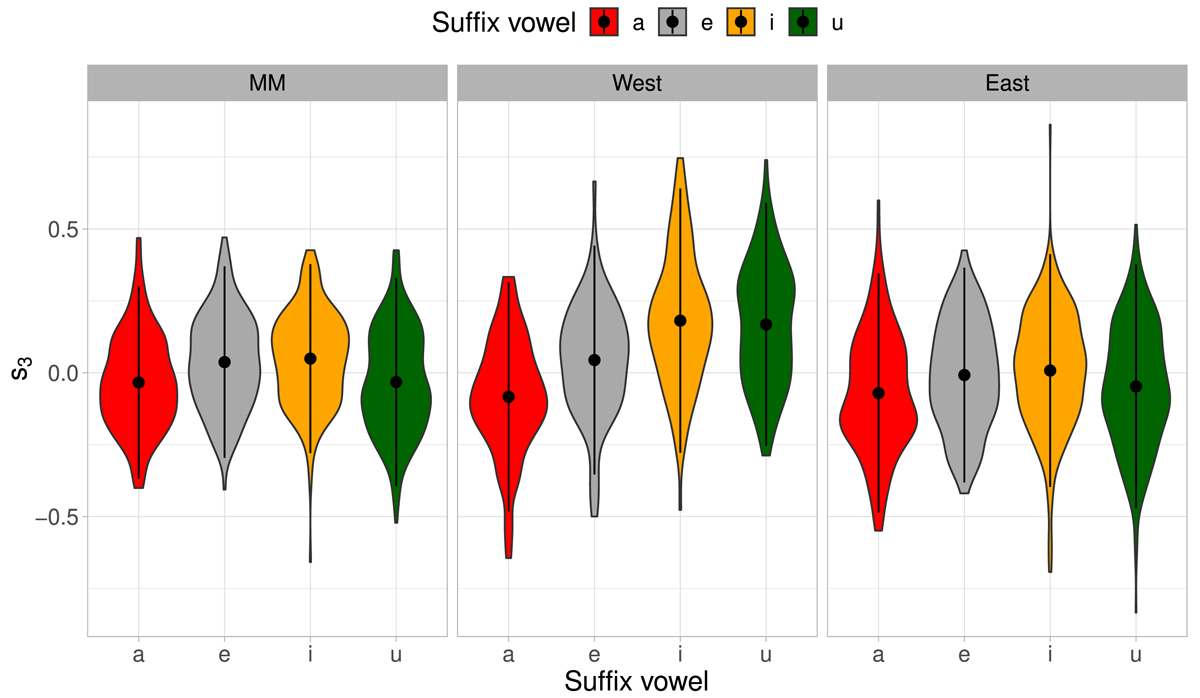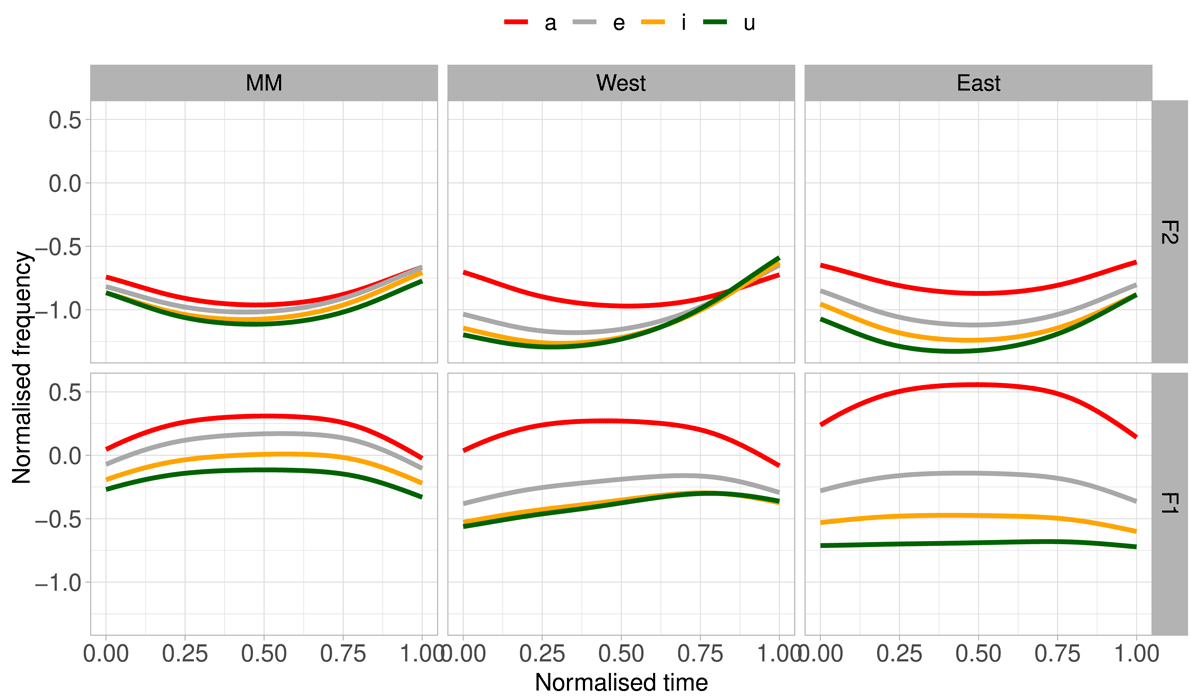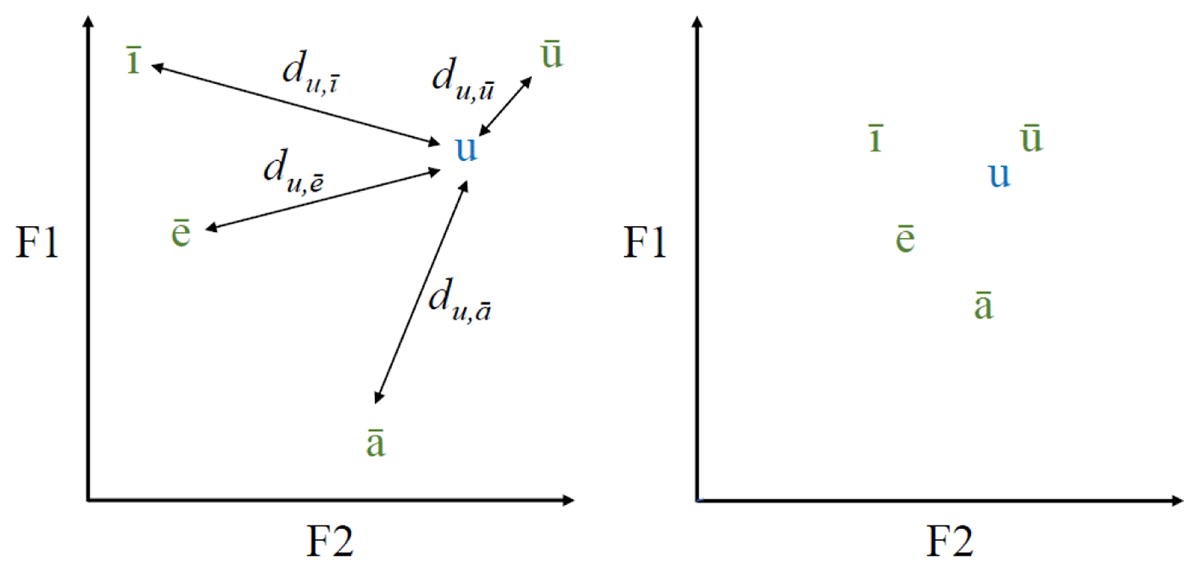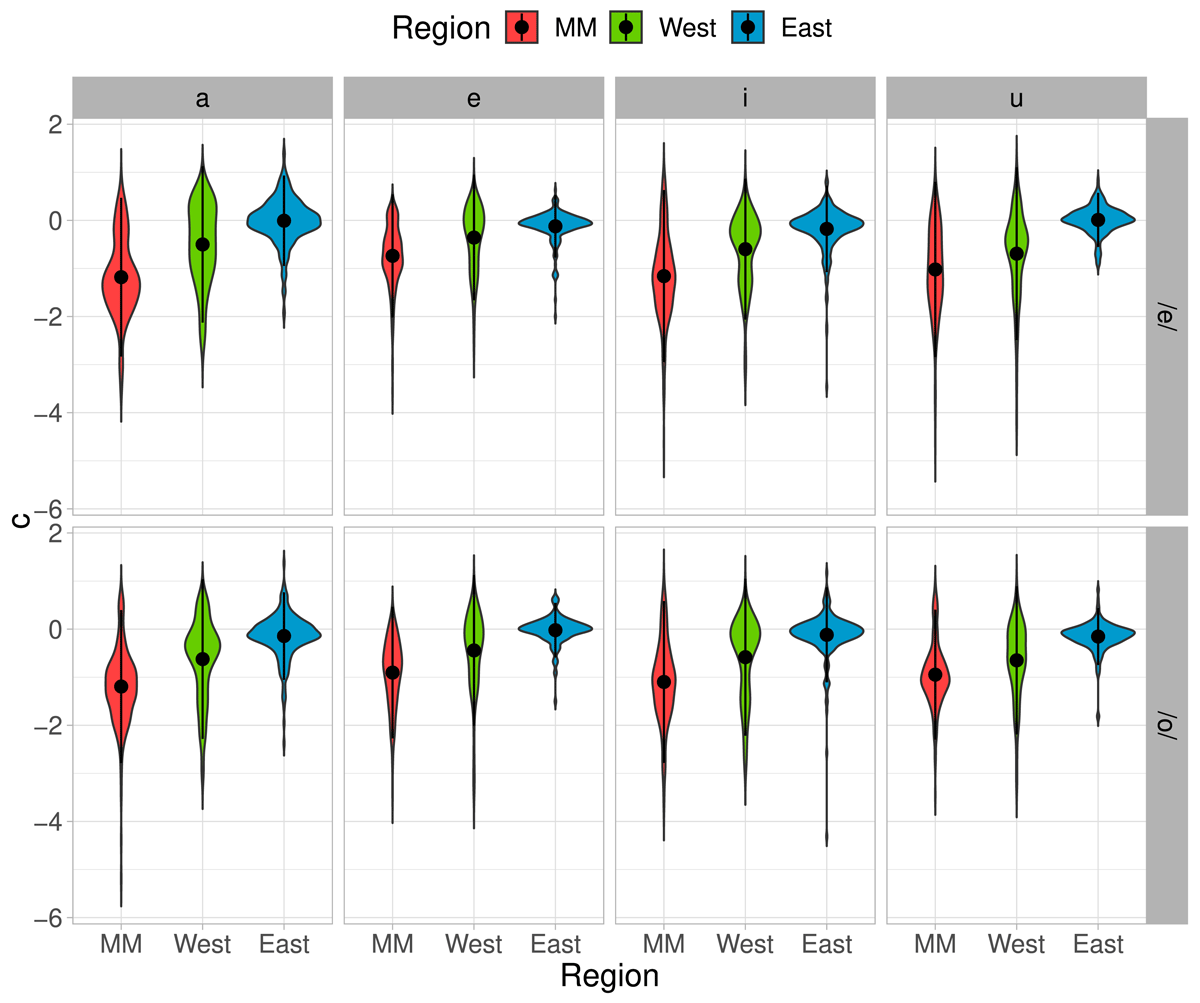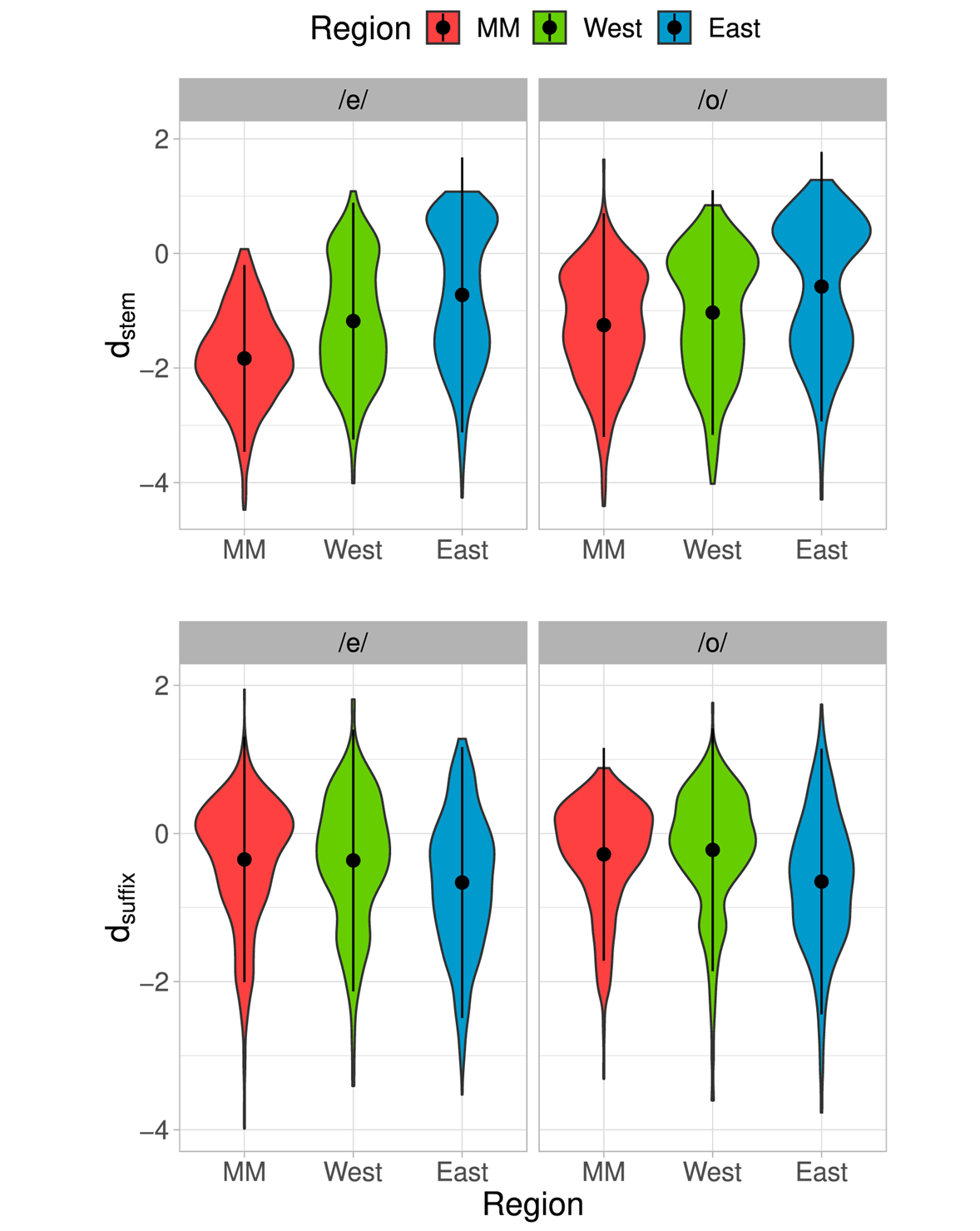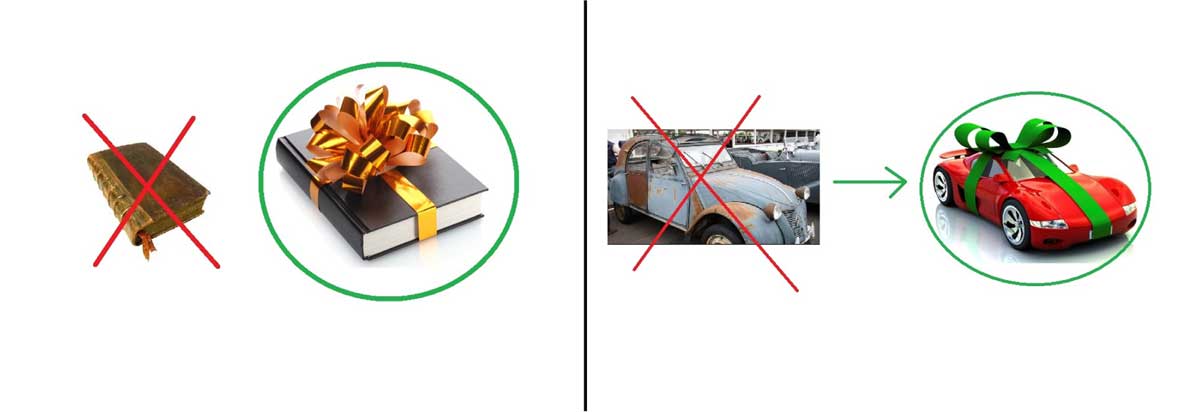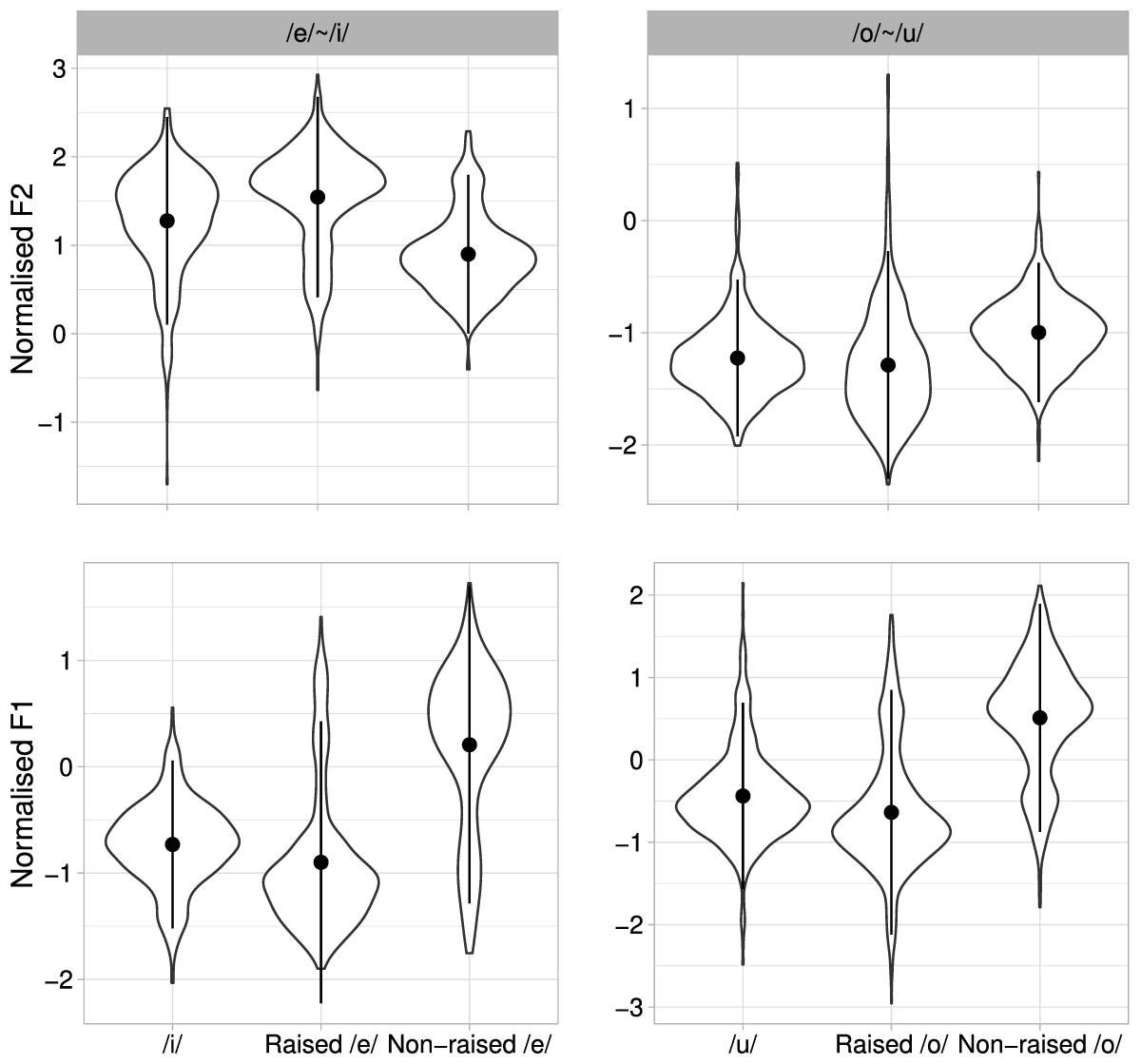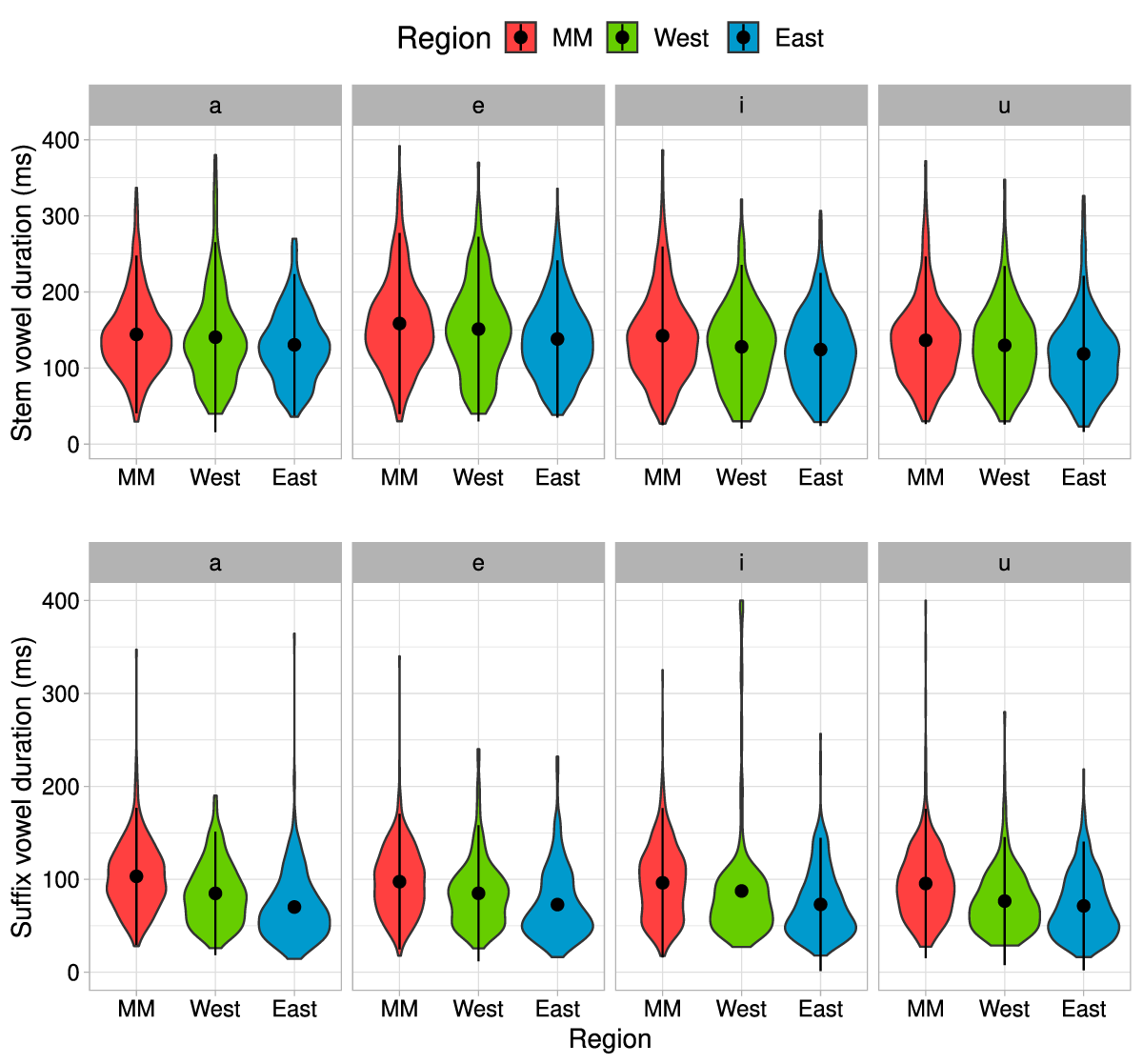1. Introduction
The focus of the present study is on metaphony in an Italo-Romance dialect region of Southern Italy known as the Lausberg area that extends across the border between Basilicata and Calabria (Lausberg, 1939; see also Conte, 2014; Martino, 1991; Romito, Galatà, Lio & Stillo, 2006; Trumper, 1979, 1997 for more recent studies). Metaphony is widespread in Romance languages, extending from Portuguese to Romanian (Loporcaro, 2016). Like umlaut in German (Iverson & Salmons, 2003; Kiparsky, 2015; Penzl, 1949; Twaddell, 1938), metaphony has its phonetic origins in trans-consonantal vowel-to-vowel coarticulation (Recasens, 2014), in which synchronically a vowel is influenced by a following vowel across one or more intervening consonants (Cole, Lindebaugh, Munson & McMurray, 2010; Hoole & Pouplier, 2017; Öhman, 1966). In metaphony, the suffix has an anticipatory influence on vowels in the preceding stem, typically in the direction of a vowel raising (Lausberg, 1939; Maiden & Savoia, 1997; Rohlfs, 1966; Schürr, 1936; Torres-Tamarit, Linke & Oostendorp, 2016). In most Southern Italian dialects, metaphony affects primarily stems containing phonetically mid vowels (Lausberg, 1939; Rensch, 1964; Rohlfs, 1966). The vowel system of dialects in the Lausberg area contrasts two mid stem vowels, /e, o/, and there is a three-way height contrast between high, mid, and low vowels (but none between mid-high and mid-low). In fact, most dialects in the area follow the so-called Sardinian vowel system (five vowels: /i, e, a, o, u/), in which Latin vowel qualities have been retained but vowel length neutralised (i.e. Lat. Ē, Ĕ > /e/, Lat. Ō, Ŏ > /o/) (Lausberg, 1939; Rohlfs, 1966; Savoia, 1997). The trigger for metaphony is typically one of two high vowels, /i, u/, in a word-final, unstressed, inflectional suffix that provides information about gender and number in nouns, and person, number, and tense in verbs. Examples of vowels preceding an /i/-suffix that are subject to metaphony are /mesi/ (‘months’), /morti/ (‘dead’, masc. pl.); and preceding a /u/-suffix /ossu/ (‘bone’), potentially leading to fully metaphonised forms in the stem such as /mis, murt, uss/, respectively.
Metaphony can be manifested, however, not only by mid-stem vowel raising, but also by diphthongisation (Lausberg, 1939; Rensch, 1964; Rohlfs, 1966). For instance, while the word ‘beautiful’, feminine singular, is /bella/, its masculine singular counterpart can be produced in some varieties as /ˈb[iǝ]llu/ or /ˈb[jɛ]llu/. Similarly, the masculine plural form of the word ‘good’ may be realised as /ˈb[uǝ]ni/ or /ˈb[wɔ]ni/, in contrast to the feminine plural counterpart /bone/. In both cases mentioned above, we can observe the presence of opening diphthongisation of the mid stem vowels /e, o/ triggered by the word-final high suffixes /i, u/. Based on a detailed analysis of raising and diphthongisation in Romance languages, Loporcaro (2016) argues firstly that the two processes are independent, and secondly that in Southern Italo-Romance “metaphonic raising occurred first, to then yield to metaphonic diphthongisation in a substantial subset of the dialects of Southern Italy.” (p. 83). In line with Loporcaro (2016), both Lausberg (1939, p. 40) and Rensch (1964, p. 30) suggested that metaphony by raising historically preceded the merger of Proto-Romance mid-high and mid-low vowels (which derived from long and short Latin vowels respectively) into the two mid-vowel categories, /e, o/, of the Lausberg dialects, while diphthongisation was an innovation that mainly affected etymologically mid-low vowels and that for most varieties came after the establishment of the Sardinian vowel system. They also pointed out, however, that some etymologically mid-high vowels might possibly show metaphonic diphthongisation in some words but not in other ones, depending both on whether the affected syllable is open or closed – the latter being a preferential target for diphthongisation (Lausberg, 1939) – and on the chronological point at which the establishment of the merger between mid-low and mid-high vowels and of diphthongisation came into being in each dialect (Rensch, 1964, p. 31). Given that there is no transparent phonetic reason why stem vowels should diphthongise as a consequence of anticipatory coarticulatory influences from the suffix, Loporcaro (2016) further suggests that diphthongisation occurs at a stage in the life-cycle of metaphony when it comes under increasingly phonological control and is therefore far less subject to phonetic conditioning (Bermúdez-Otero, 2015; Bermúdez-Otero & Trousdale, 2012; Kiparsky, 2015; Ramsammy, 2015). For the present sound change, this would mean that stem vowel changes could develop phonetic innovations (such as diphthongisation) that are not caused by the time-varying anticipatory coarticulatory influence of the suffix on the stem vowel.
Both metaphony and umlaut have in common with other types of sound changes that a coarticulatory effect becomes contrastive as the source or origin of the coarticulation is weakened or even completely eliminated (Walker, 2005). Thus, the historical development of contrastive nasalisation in French (e.g. main, /mɛ̃/ < Latin manus, ‘hand’) must have derived from a vowel that was originally non-contrastively nasalised followed by the loss of the following nasal consonant. In tonogenesis (Hagège & Haudricourt, 1978; Hombert, Ohala & Ewan, 1979), intrinsic pitch differences caused by an initial voicing contrast of a stop contrast developed into contrastive tones on the vowel combined with neutralisation of stop voicing (see also e.g. Coetzee, Beddor, Shedden, Styler & Wissing, 2018; Kirby & Ladd, 2015, 2016 for related studies).
The last two decades have seen some progress in understanding how during the progression of a sound change a coarticulatory effect could be maintained or even enhanced as its coarticulatory source is diminished. Some studies (Beddor, 2009; Beddor, Coetzee, Styler, McGowan & Boland, 2018; Cronenberg, Gubian, Harrington & Ruch, 2020; Harrington, 2012) suggest that a trading relationship (Haggard, Summerfield & Roberts, 1981; Repp, 1982) governs a sound change’s transition from phonetically based coarticulation towards the development of a new phonological contrast. The physiological basis of a trading relationship between coarticulatory effect and its source is that autonomous, gestures of constant articulatory duration can be variably phased (Browman & Goldstein, 1992; Fowler, 2005; Fowler & Smith, 1986). Thus, if the velum lowering gesture in VN sequences is anticipated earlier in the vowel, and if this gesture’s duration is fixed, then the duration of the nasal closure must be correspondingly less. Such a model has been shown to work quite well for explaining how in American English VN sequences, the primary cue for nasalisation can incrementally shift from the nasal consonant to the preceding vowel (Beddor, 2009; Beddor et al., 2018; Beddor, McGowan, Boland, Coetzee & Brasher, 2013). A more recent physiological study by Carignan et al. (2021) on nasalisation in German shows, however, that the trading relationship cannot just be explained by rephasing. Their evidence suggests that the path to sound change may involve no change in the temporal extent of nasalisation in the vowel, but rather a decrease in the magnitude of velum lowering in the nasal consonant. The conclusion from these separate studies on American English and German is nevertheless similar: In contexts in which vowel nasalisation and nasal loss are most likely (e.g., either in American English sent vs send, or German Senta vs senden), there is a proportional increase in the degree of nasalisation in the vowel (whether in time or magnitude) relative to the following nasal consonant. Such findings lend support to the idea that the enhancement of the coarticulatory effect and attrition of the coarticulatory source are inversely related.
How might a trade-off be manifested in Italo-Romance metaphony? Here the prediction is clear enough: The expectation is that cues to the inflectional suffix should be reciprocally distributed between the stem and suffix vowels. That is, there might on the one hand be speakers who cue the distinction between the singular and plural of ‘months’ predominantly in the suffix as do speakers of Standard Italian (i.e. /mese, mesi/). By contrast, speakers with the most advanced forms of metaphony will make the distinction entirely in the stem (i.e. /mes, mis/) and delete the suffix, while other speakers might be between these extremes and distribute the cues to morphological inflection in different reciprocal strengths between the stem and suffix. Certainly, final unstressed vowel neutralisation and deletion are common in varieties of Southern Italy (Bucci, Perrier, Gerber & Schwartz, 2019; Delucchi, Cangemi & Loporcaro, 2012; Lausberg, 1939; Rohlfs, 1966; Romano, 2020; Russo & Barry, 2004, among others). But whether such trade-off relationship between stem enhancement and attrition of the suffix exists for a population of speakers in dialect areas characterised by metaphony has not so far been investigated.
Various auditory phonetic studies have been carried out of the Lausberg area beginning with the author after which the region is named (Lausberg, 1939) and extended by other detailed follow-up analyses (Conte, 2014; Rensch, 1964; Romito et al., 2006; Trumper, 1997). There is some consistency across these studies that regions within the Lausberg area do indeed differ in whether metaphony is manifested primarily as raising or as diphthongisation or, possibly, even both. The map and analyses by Rensch (1964) (Figure 1) show, for example, that diphthongisation predominates in and around a large area of the west coast of the Lausberg area (sometimes referred to as the Zwischenzone, see Lausberg, 1939) but that within this area there are some perhaps more isolated villages such as Mormanno and Rotonda (Martino, 1991, p. 46; Savoia, 1997, p. 371; Savoia, 2015, p. 209) that have not undergone metaphonic diphthongisation – although Rensch (1964), comments that diphthongisation may sometimes occur synchronically alongside non-diphthongised forms in Mormanno. On the east coast (in a region sometimes known as the Mittelzone; see Lausberg, 1939) by contrast, there is a cluster of villages that Rensch (1964, p. 20) characterises as “reduzierende Orte” (‘reducing villages’). Rensch’s categorisation of these villages as “reduzierend” means that metaphony may well once have been diphthongal in this region, but that the diphthongal quality has since been ironed out, leading to a monophthongal variant that is nevertheless different from that found in Mormanno (as pointed out by Martino, 1991, and Savoia, 1997, 2015) in being further raised. Trumper (1997, p. 361) is more explicit in this regard in commenting “many dialects in the (…) ‘Middle Zone’ have monophthongised all metaphonic diphthongs as phonetically long high vowels [iː], [uː] (*[ˈbɛllu] > *[ˈbiellu] > [ˈbiːllə], *[ˈkɔktu] > *[ˈkuottu] > [ˈkuːttə])”.
The classification of villages of the Lausberg area by Rensch (1964, p. 21) into diphthongising (filled circle), non-diphthongising (open circle), and reducing. The villages from which recordings were made in the present study are highlighted in colour: green for Mormanno (MM), red for the Zwischenzone (West), blue for the Mittelzone (East).
Two predictions are tested in this study based on the auditory phonetic analyses and models of sound change discussed above. The first is that information about the inflectional suffix in the stem follows the progression (where “<” means is less informative): MM (Mormanno) < West (Zwischenzone) < East (Mittelzone), where the ‘West’ includes villages exhibiting diphthongal metaphony on the west coast and where the ‘East’ includes villages characterised by the ‘reducing’ (and further raising) form of metaphony on the east coast (see Figure 1). The second prediction is that the degree of suffix erosion is MM < West < East. The basis for this prediction is the trade-off outlined earlier, in which the cues to coarticulatory effect and source – and, in this case, to inflectional morphology as well – are reciprocally distributed between the stem and suffix: Thus, the greater the available information in the stem, the weaker the information in the suffix, and vice-versa.
The first prediction was tested in Section 2 by analysing the influence of region and suffix vowel context on the shape trajectories of stem vowel formants. The second prediction was tested in Section 3, by analysing suffix vowel deletion (Section 3.1.1) and degree of centralisation (Section 3.1.2). Finally, a test was made of the relationship between suffix erosion and stem enhancement within each region and within the individual (Section 3.1.3).
2. Acoustic analysis of stem vowels
The aim of this part of the study was to determine whether the influence of the suffix on the stem vowels differed between the three regions. For this purpose, the shape of the first two formant frequencies in the stem vowel were quantified using functional principal components analysis, henceforth FPCA (Gubian, Torreira & Boves, 2015; Ramsay & Silverman, 2010). The output of FPCA is a set of principal components (PCs), which parameterise the shapes of F1 and F2 together, and an associated set of PC scores or weights that model how these shapes are connected to the individual stem vowel tokens.
The PCs were predicted to encode phonetic height and diphthongisation, given that these are two of the main features that are reported to occur in stem vowel metaphony. This prediction is tested in Section 2.1. The PC scores were predicted to show region-specific differences: That is greater diphthongisation in the West than in the other two regions; and a wider variation in phonetic height in the East compared with the West compared with MM. These predictions were tested in Section 2.2.
2.1. Formant trajectory shapes in the stem
As discussed above, the main aim in this section was to determine the extent to which the principal components applied to F1 and F2 trajectories together encoded phonetic height and diphthongal variation within stem-/e/ and within stem-/o/ vowels.
2.1.1. Method
2.1.1.1. Speakers and villages
Recordings were made in quiet conditions in the homes of 35 participants (18 females and 17 males) from eight villages in the Lausberg area. These were chosen because, following previous impressionistic studies (Lausberg, 1939; Martino, 1991; Rensch, 1964; Savoia, 1997, see Section 1), they are expected to present the three different types of metaphony attested in the area, i.e. raising from mid to mid-high vowels (Mormanno), raising from mid to high vowels (East), and diphthongisation of stem vowels (West). The participants were recruited from personal contacts of the first author (a native speaker of this region) and on social media. They were paid a small amount of money for their participation. Before carrying out the recordings, all participants answered some questions related to their age, degree of education, and use of dialect in everyday life. Only participants who spoke the local variety frequently and proficiently were recruited. The mean age of the subjects was 48.9 years. Figure 2 shows the villages and regions involved and the number of speakers recorded in Mormanno (MM) and from the villages of the West (‘Zwischenzone’ in Lausberg, 1939) and from the the East (‘Mittelzone’). A further summary of some of the speaker attributes and numbers per village is shown in Appendix A, Table 7.
The Lausberg area (Map data © 2021 Google) and its main internal subdivisions (based on Pellegrini, 1977, and Trumper & Maddalon, 1988), including villages and numbers of speakers per village involved.
2.1.1.2. Materials and data elicitation
The lexical items containing the analysed stem and suffix vowels were elicited through a picture-naming task. The recordings were made using a laptop and a headset with integrated microphone (Sennheiser SC 60). The picture-naming task was carried out using the computer software SpeechRecorder (version 3.28.0) (Draxler, 2011) with one picture per inflected form of each lexical item. The order of appearance of these pictures was randomised differently for each speaker. Inflected adjectives were elicited in combination with a noun. The nouns and adjectives were first produced in isolation, and subsequently within the carrier sentence “I say … two times” ([(jɛ) ˈdiku … dui ˈvotə]), in the dialect. Verbs could not be elicited in isolation but within a sentence that was described by a picture, so the same sentence containing the target verb had to be repeated twice (see Appendix B for some examples of eliciting stimuli).
The target words were primarily selected on the basis of their stem vowel phoneme, which in most cases corresponded to the stem vowel in the Latin etymon (the dialects analysed in this study all share the so-called Sardinian vowel system, in which the vowel qualities of Latin are preserved, see Section 1). Also, the word list aimed to represent all possible stem vowel/suffix vowel combinations. Because of the elicitation method chosen, the word choice had to be based on picturable items only, thus excluding function words or words referring to abstract concepts.
All target words analysed in this paper had primary stressed /e, o/ stem vowels combined with word-final, lexically unstressed suffix /i, e, a, u/ vowels. Most word types (n = 85) were disyllabic, while there were some words (n = 30) that were trisyllabic and in which the stem and suffix vowels were either adjacent (e.g. /niˈpote/, ‘grandchild’) or separated by one syllable (e.g. /ˈtenisi/, ‘(you) have’); see Appendix C, Table 8). The relationship between morphological inflection and suffix vowels is shown in Table 1.
The suffix vowels and their inflectional meaning, with examples of words (phonemic transcription) for both stem vowels.
| Suffixes | Inflectional meaning | Examples | |
| Stem-/e/ | Stem-/o/ | ||
| /a/ | Feminine singular (adjectives and nouns) | bella ‘beautiful’ | bona ‘good’ |
| Feminine plural (irregular; nouns) | – | ossa ‘bones’ | |
| Present indicative, 3rd pers. sg. (1st-conjugation verbs) | pensa ‘(s)he thinks’ | trova ‘(s)he finds’ | |
| /e/ | (Mostly masculine) singular (adjectives and nouns) | verme ‘worm’ | niˈpote ‘grandchild’ |
| Present indicative, 3rd pers. sg. (2nd-conjugation verbs) | tene ‘(s)he has’ | more ‘(s)he dies’ | |
| Feminine plural (adjectives and nouns) | mele ‘apples’ | bone ‘good’ | |
| /i/ | (Mostly masculine) plural (adjectives and nouns) | vermi ‘worms’ | niˈpoti ‘grandchildren’ |
| Present indicative, 2nd pers. sg. (verbs) | ˈtenisi ‘you have’ | ˈmorisi ‘you die’ | |
| /u/ | Masculine singular (nouns) | bellu ‘beautiful’ | bonu ‘good’ |
| Present indicative, 1st pers. sg. (verbs) | tengu ‘I have’ | moru ‘I die’ | |
A total of 118 words were elicited that included 28 lexical items with stem-/e/ and 27 with stem-/o/ (Appendix C, Table 8). The total number of potentially available vowels for analysis for stem-/e/ was: 60 words (stem and suffix combinations) × 2 repetitions × 35 speakers = 4200 tokens; and for stem-/o/: 58 words × 2 repetitions × 35 speakers = 4060 tokens. However, some productions had to be removed because they had either been misarticulated, or produced in Standard Italian, or did not correspond to the target word: this left 2752 stem-/e/ and 2620 stem-/o/ vowels for the analysis. The final count of the produced words is shown in Table 2.
Count of the stem vowels that were analysed in this study by suffix vowel and region.
| Stem vowel | /e/ | /o/ | |||||||
| Suffix vowel | /a/ | /e/ | /i/ | /u/ | /a/ | /e/ | /i/ | /u/ | |
| Metaphonic context | ✔ | ✔ | ✔ | ✔ | |||||
| Region | MM | 186 | 244 | 319 | 274 | 257 | 178 | 235 | 292 |
| West | 97 | 125 | 160 | 122 | 132 | 85 | 122 | 145 | |
| East | 222 | 284 | 373 | 346 | 317 | 181 | 299 | 377 | |
| All regions | 505 | 653 | 852 | 742 | 706 | 444 | 656 | 814 | |
Along these words carrying mid stem vowels, other words (see Appendix D) were elicited that carried high and low /i, a, u/ stressed stem vowels (i.e. the three corner vowels of the vowel systems of the dialects analysed). These words were not analysed in this study, but only used to extract the F1 and F2 values of their stem vowels that were necessary for the Lobanov-normalisation of the /e, o/ stem vowel formants (see Section 2.1.1.3).
2.1.1.3. Data pre-processing
The speech signals were semi-automatically segmented and labelled using the MAUS (Munich Automatic Segmentation System) forced alignment system (Kisler, Reichel & Schiel, 2017), which is integrated in the emuR package (version 1.1.2) (Winkelmann, Harrington & Jänsch, 2017) available in the R programming environment. The first two formant frequencies (F1, F2) of stem and suffix vowels were calculated using the Praat formant tracker included in the PraatR package (version 2.4) (Albin, 2014) in R with a 25 ms window and a 5 ms frame shift. Around 40% of the data were manually corrected for misplaced segment boundaries or mistracked formants.
All formant trajectories were linearly time-normalised into 11 equally-spaced time points between the acoustic onset and offset of the stem vowel. A speaker-normalisation procedure based on Lobanov (1971) was applied with (1):
(1)
in which and are, respectively, the time-normalised and raw formant frequency values of formant number j (j = 1, 2) produced by speaker i in utterance k at time-point t, and where mean (F)i,j and sd(F)i,j are the mean and the standard deviation of all formant values between the acoustic onset and offset for formant number j (in our case for each F1 and F2) with respect to the speaker’s /a/, /i/, and /u/ stem vowels contained in the words listed in Appendix D.
2.1.1.4. Functional principal component analysis (FPCA)
The time-normalised sampled formant track pairs (F1, F2) were interpolated by means of standard smoothing techniques using B-splines, which are sequences of polynomial functions that, when multiplied by coefficients and summed, reproduce a sampled data contour by approximation to the original shape (Gubian et al., 2015). As a result, each vowel token of /e/ or /o/ was represented by a pair of continuous functions F1i(t) and F2i(t), in which i is the token index and t is the continuous, normalised time variable. This set of function pairs was the input to FPCA, which produced a parameterisation of the form:
(2a)
(2b)
in which μF1(t) and μF2(t) are the mean formant tracks, PCkF1(t) and PCkF2(t) are K pairs of Principal Component curves (PCs, k = 1, ⋯, K), which are fixed and depend on the entire data set, and sk,i are scores, which are weights on the PCks (with one vector of weights per stem vowel token). The formant track pair of any individual vowel stem token can be reconstructed from (2): Essentially, the greater the number of PCs, the closer the approximation to the token’s raw F1 and F2 trajectories.
FPCA was applied separately to the 2752 stem-/e/ tokens and to the 2620 stem-/o/ tokens. In both cases, the first K = 3 PCs were considered, which in combination explained around 95% and 93% of the FPCA variance for the stem-/e/ and stem-/o/ data respectively. The reason why FPCA was applied separately to /e/ and /o/ is because the extensive formant frequency differences between /e, o/ would otherwise have masked the much smaller differences caused by the influence of the suffix on the stem vowel.
2.1.2. Results
Figures 3 and 4 illustrate the type of shape variation is captured by each PC for the FPCA based on stem-/e/ and stem-/o/ vowels respectively. Each panel isolates the effect of one PC, say PCk, by displaying several colour-coded curves, each one obtained by substituting a different value of the corresponding score sk into equations (2a) and (2b), setting all other scores to zero. For example, the top mid panel in Figure 3 shows curves of the form μF2(t) + s2 ∙ PC2F2(t). The values used for scores sk are equally spaced ranging between – 1 (blue) and + 1(red) standard deviations ( ). The value sk = 0 corresponds to the mean curve across the entire data for that vowel (thick black lines), and is therefore the same across panels of the same stem vowel and formant.
Turning firstly to /e/, as far as PC1 is concerned (Figure 3, left panels), decreasing and increasing s1 caused F1 and F2 to shift further apart (blue) or to come closer together (red) respectively. Thus, the s1 modulation of PC1 brought about a type of variation that is consistent with both a phonetic raising and simultaneous fronting, i.e. the change between the extreme blue/red trajectories for PC1 in the left panels of Figure 3 is likely to correspond to a shift from a (peripheral) phonetically high front [i] vowel (blue trajectories, in which F1 and F2 are maximally far apart) in the direction of phonetic centralisation and lowering, possibly in the direction of [e] or [ɛ]. The s2 modulation of PC2 (central panels in Figure 3) caused both formants either to decrease in frequency (blue trajectories) or to increase together (red trajectories). The phonetic interpretation of PC2 is less transparent than the one for PC1: It might, on the one hand, act to constrain the variation in PC1, but it could also be associated with a shift from a less (red trajectories) to a more (blue trajectories) rounded vowel, given that vocal tract lengthening due to lip rounding causes a decrease in formant frequencies (especially in F2, see e.g. Lindblom & Sundberg, 1971, and Figure 2 in Vaissière, 2009, p. 24). The changes to the formant shapes caused by s3 modulations of PC3 were from (i) to (ii):
Blue trajectories: In the first part of the vowel, F1 is above the mean curve and F2 is below the mean curve. Since the mean curve refers in this case to the /e/ stem vowel, then this quality corresponds to a tongue lowered [e̞] or to [ɛ]. In the second part of the vowel, F1 is below the mean and F2 above the mean. This is typical of a quality such as a tongue raised [e̝] or [i]. Consequently, the blue line from the vowel onset to the offset represents a range of phonetically closing diphthongs such as [e̞e̝] or [ɛi].
Red trajectories: These are more or less the mirror image on the time axis of the blue ones. Thus, the red trajectories from the vowel onset to the offset represent a range of phonetically opening diphthongs such as [e̝e̞], [ie] or [jɛ].
Thus, the shift from (i) to (ii) corresponds to the variation between a closing and opening diphthong.
The type of variation associated with the PCs for stem /o/ in Figure 4 bears a striking similarity to that of stem /e/. As far as PC1 is concerned (Figure 4, left panels), decreasing s1 caused a lowering of both formants: That is, the change from negative (blue trajectories) to positive (red trajectories) s1 values corresponds to a shift from a phonetically high vowel, in this case [u], towards a lower and more central vowel such as [ɔ] or [o]. The type of variation in PC2 is similar to that of PC1 except that, for PC2, F1 changes minimally: Thus, the transition from blue to red trajectories in PC2 might correspond phonetically to an increase in vowel frontness or backness, but without much change in phonetic height. The s3-induced variation in PC3 brings about a change in diphthongal quality from (i) to (ii):
Blue trajectories: In the first part of the vowel, both formants are above their respective means. Since the mean refers in this case to stem /o/, this quality possibly corresponds to a tongue lowered [o̞] or [ɔ]. In the second part of the vowel, both formants are below their respective means. This is typical of a quality in which the tongue is raised as for tongue raised [o̝] or [u]. Consequently, the blue line from the vowel onset to the offset represents a range of phonetically closing diphthongs such as [o̞o̝] or [ɔu].
Red trajectories: These are more or less the mirror image on the time axis of the blue ones. Thus, the red trajectories from the vowel onset to the offset represent a range of phonetically opening diphthongs such as [o̝o̞], [uo] or [wɔ].
Thus, as for stem /e/, the change from (i) to (ii) represents a shift from a phonetically closing to an opening diphthong.
2.1.3. Discussion
The separate application of FPCA to the formant trajectories of /e/ and of /o/ resulted in a set of k PCs such that each one encoded different aspects of the variation in the formant trajectories across speakers and words. PC1 is likely to be associated with simultaneous variations in phonetic height and frontness/backness either between high front and low-mid front in the case of /e/, or between high back and low-mid back in the case of /o/. The phonetic interpretation of PC2, instead, might be related to a variation in lip rounding for /e/ and in phonetic backness for /o/. PC3 for both /e/ and /o/ encode variations between phonetically closing and opening diphthongs.
The issue to be considered next is the extent to which these variations in the formant trajectories were connected to the metaphonic influence of V2 on V1 and with the differences between the three regions. For this purpose, the analyses in the following sections were based on PC1 and PC3 and relative scores, given the evidence so far that metaphony is mainly associated with variations in phonetic peripherality (modulated by s1) and diphthongisation (modulated by s3) in the stem vowel.
2.2. Regional variation
The more specific hypotheses to be tested were that (i) the influence of the suffix on the stem was greatest for the East, intermediate for the West, and least for MM and (ii) that the West was differentiated from the other two regions by diphthongisation.
2.2.1. Method
The PC-scores s1 and s3 were modelled by linear mixed-effects regression models which were applied with the lmerTest package in R. The mixed models were of the form (R notation):
(3)
in which the response s was one of two PC-scores and in which there were fixed factors suffix (four levels: /i, e, a, u/) and region (three levels: MM, West, East) and their interaction. Stem was a unique identifier for the lexical stem of the word independently of its suffix (e.g. the stem representation for the different inflected forms of ‘months’ was /mes/). The random factors originally included intercepts and all logically possible slopes to measure the interaction between the fixed and random factors. These were dropped if they were non-significant, resulting in the final model shown in (3) that was applied separately to the stem-/e/ and stem-/o/ data. Post-hoc tests were computed using the emmeans package in R whenever the two fixed factors interacted. Finally, expected F1 and F2 trajectories were obtained by first computing estimated marginal means of s1 and s3 for each combination of the fixed factors from the LMER models in (3), and then by substituting those values into Eq. (2) (setting the other scores to zero).
2.2.2. Results
2.2.2.1. Stem-/e/
Consistently with the analysis in Section 2.1, Figure 5 shows that s1 varied with the phonetic height of the suffix vowel. This is most evident in the East’s data in which the lowest s1 scores were in the context of suffix-/i, u/ (thus suggesting that the stem vowels are phonetically highest in these contexts – see the right panel of Figure 3) followed by stems vowels in the /e, a/ contexts respectively. Figure 5 also suggests that s1 varied by region: Where > denotes ‘the suffix vowel had a greater influence on the stem vowel’ then East > West > MM. This is evident from Figure 5 (e.g., the s1 separation between /a/ vs /e/ vs /i, u/ was greatest for the East, intermediate for the West, and least for MM).
The results of the mixed model in (3) showed a significant influence on s1 of the suffix vowel (F3, 2493.6 = 122.1 p < 0.001), of region (F2, 49.1 = 9.7, p < 0.001) and a significant interaction between these factors (F6, 1120.7 = 35.3, p < 0.001). The post-hoc tests showed significant differences between all pairs of regions for suffix-/i/ (MM vs West: p = 0.001; MM vs East: p < 0.001; West vs East: p < 0.01) and for suffix-/u/ (MM vs West: p = 0.001; MM vs East: p < 0.001; West vs East: p < 0.01), but no differences between the regions for suffix-/a/ and only one pairwise difference (MM vs West: p < 0.05) for suffix-/e/ (see Table 3 for details).
As far as s3 is concerned, which as shown in Section 2.1 is indicative of stem vowel diphthongisation, Figure 6 suggests higher scores (and hence greater opening diphthongisation) for the West compared with the other two regions, especially in the context of suffix-/i, u/. The results of the mixed model (3) with s3 as the dependent variable showed a significant influence of suffix (F3, 2632.7 = 11.9, p < 0.001), a not quite significant influence of region (F2, 48.8 = 3.1, p = 0.5), and a significant interaction between these factors (F6, 2068.1 = 14.7, p < 0.001). The post-hoc tests showed a significant difference between the West and the other two regions for suffix-/i/ (MM vs West: p < 0.05; West vs East: p < 0.01) and for suffix-/u/ (MM vs West: p < 0.001; West vs East: p < 0.001). There were no significant differences between any of the regions for suffixes-/e, a/ (see Table 3 for details).
The reconstructed formants from the estimated marginal means of s1 and s3 (see Section 2.2.1) in Figure 7 shows trends that are entirely consistent with the above analyses. In particular, Figure 7 shows a greater influence of the suffix on F1 and F2 in the East than in the West than in MM; and also that there was a greater degree of diphthongisation in the West than in the other two regions (see also Appendix E, Figure 19, for some lexical examples with spectrograms).
2.2.2.2. Stem-/o/
For stem-/o/, Figure 8 shows that the extent of influence of the region on s1 was East > West > MM. The results of the statistical model in (3) applied to these data showed a significant influence on s1 of the suffix vowel (F3, 1995.6 = 253.6, p < 0.001), of region (F2, 44.2 = 6.3, p < 0.01) and that there was a significant interaction between these factors (F6, 889.0 = 37.7, p < 0.001). The results of the post-hoc tests showed a significant difference between MM and the East in the context of all four suffix vowels (/i/: p < 0.001; /u/: p < 0.001; /e/: p < 0.01; /a/: p < 0.05). There were significant differences between MM and the West in three suffix vowel contexts (/i/: p = 0.001; /u/: p < 0.05; /e/: p < 0.01) but not in /a/. There were differences between the West and the East in the context of suffix-/u/ (p < 0.01) and suffix-/a/ (p < 0.05) but not in the context of the other two suffix vowels (see Table 3 for details).
Concerning s3, Figure 9 shows higher s3 values – and therefore greater opening diphthongisation – for the West than for the other two regions. The application of the statistical model in (3) to these data showed a significant influence on s3 of suffix vowel (F3, 2504.7 = 17.9, p < 0.001), of region (F2, 42.7 = 5.0, p = 0.01) and a significant interaction between these factors (F6, 465.6 = 17.7, p < 0.001). The results of the post-hoc tests showed significant differences between the West and the other two regions in the context of suffix-/i/ (West vs East: p < 0.001; MM vs West: p < 0.01) and suffix-/u/ (West vs East: p < 0.001; MM vs West: p < 0.001) but not for the other two suffix vowel contexts (see Table 3 for details). There were no significant differences between MM and the West in any contexts. Compatibly with these results, the reconstructed formants from the estimated marginal means in Figure 10 show firstly that the influence of the suffix was greatest for the East followed by the West followed by MM, and that there was a greater degree of diphthongisation for the West than for the other two regions (see also Appendix E, Figure 20, for some lexical examples with spectrograms).
2.2.3. Discussion
These results show that suffix vowels influenced the phonetic height of stem vowels. This effect is most clearly seen in the reconstructed formant plots for F1 in MM and the East in Figures 7 and 10, in which the stem vowels – especially for the East1 – had a progressively higher F1 in the context of suffix vowels /a/ vs /e/ vs /i, u/. A new finding in this regard is that the stem vowel change occurs not just for high suffix vowels as most of the literature on Italo-Romance metaphony suggests (Calabrese, 1998; Maiden & Savoia, 1997; Rohlfs, 1966; Torres-Tamarit et al., 2016), but also in the context of suffix-/a/. In all three regions stem vowels were found to be lowered in the context of suffix vowel /a/ and increasingly so from MM to West to East. If there were no effect of suffix-/a/ on the stem vowels, then there should have been no difference between the quality of the stem vowels before suffix /e, a/, but this was not the case: As Figures 7 and 10 show, F1 in the context of suffix-/a/ within any region is typically higher (thus signalling a vowel lowering) compared with F1 in the context of suffix-/e/.
The extent of the influence of the suffix vowel on the phonetic height in the stem varied between regions. The influence of the suffix vowel was most marked in the East and least in MM. These MM–East differences are once again apparent in the reconstructed formants, in which, especially for stem-/o/, the F1-separation due the suffix vowel was considerably greater in the East than in MM. For the West, the influence of the suffix vowel on stem vowel height was more marked than in MM but not as marked as for the East. This is also shown by the reconstructed formant plots in Figures 7 and 10, for which the F1-separation in the suffix vowel contexts is intermediate between that for MM and for the East.
In the West, but not in the other two regions, the influence of the suffix vowel was associated with diphthongisation in the stem vowel. Compatibly, the reconstructed formant trajectories in Figures 7 and 10 show a diphthongal quality to the West’s stem vowels and a greater suffix-dependent formant separation in the initial compared with the final part of the formant trajectories.
The concern of the next section is to consider whether the phonetic information for the suffix vowel is reciprocally distributed between the stem and the suffix, such that the more information that there is in the former the less there is in the latter, and vice-versa.2
The estimated mean (m) and standard error (SE) of the statistically significant s1 and s3 contrasts between regions, separately for stem vowel and suffix vowel, and the associated post-hoc t-statistics (final three columns; *** p ≤ .001; ** p ≤ .01; * p ≤ .05).
| Regions | Stem vowel | PC-score | Suffix vowel | m | SE | df | t | Sig. |
| MM – East | /e/ | s1 | /i/ | 0.75 | 0.11 | 53.0 | 6.7 | *** |
| /u/ | 0.79 | 0.11 | 55.0 | 7.0 | *** | |||
| /o/ | s3 | /a/ | –0.24 | 0.10 | 65.2 | –2.4 | * | |
| /e/ | 0.30 | 0.11 | 86.0 | 2.8 | ** | |||
| /i/ | 0.47 | 0.10 | 68.7 | 4.6 | *** | |||
| /u/ | 0.56 | 0.09 | 61.2 | 5.7 | *** | |||
| MM – West | /e/ | s1 | /e/ | 0.23 | 0.09 | 78.1 | 2.4 | * |
| /i/ | 0.34 | 0.09 | 66.1 | 3.7 | *** | |||
| /u/ | 0.34 | 0.09 | 76.3 | 3.6 | *** | |||
| s3 | /i/ | –0.17 | 0.06 | 63.7 | –2.8 | * | ||
| /u/ | –0.24 | 0.06 | 67.2 | –3.8 | *** | |||
| /o/ | s1 | /e/ | 0.35 | 0.10 | 65.5 | 3.4 | ** | |
| /i/ | 0.35 | 0.09 | 54.7 | 3.7 | *** | |||
| /u/ | 0.26 | 0.09 | 50.8 | 2.8 | * | |||
| s3 | /i/ | –0.10 | 0.03 | 82.4 | –3.5 | ** | ||
| /u/ | –0.16 | 0.03 | 74.3 | –5.7 | *** | |||
| West – East | /e/ | s1 | /i/ | 0.41 | 0.13 | 52.4 | 3.2 | ** |
| /u/ | 0.46 | 0.13 | 56.5 | 3.5 | ** | |||
| s3 | /i/ | 0.18 | 0.06 | 63.8 | 3.1 | ** | ||
| /u/ | 0.29 | 0.06 | 67.0 | 4.8 | *** | |||
| /o/ | s1 | /a/ | –0.28 | 0.10 | 71.4 | –2.7 | * | |
| /u/ | 0.31 | 0.10 | 67.1 | 3.0 | ** | |||
| s3 | /e/ | 0.11 | 0.04 | 82.1 | 2.9 | ** | ||
| /i/ | 0.15 | 0.03 | 63.3 | 4.2 | *** | |||
| /u/ | 0.15 | 0.03 | 56.7 | 4.3 | *** |
3. Analysis of suffix erosion
The prediction was tested that MM < West < East, where ‘<’ denotes the extent of suffix erosion. The erosion of the suffix was quantified by analysing separately the extent of suffix deletion (Section 3.1.1) and suffix centralisation (Section 3.1.2).
3.1. Method
The lexical items were the same as those for the stem vowel analysis. Table 4 shows the number of suffix vowel tokens analysed (also including the number of deleted ones), separately by region, stem vowel of the lexical items to which the suffixes in question were attached, and suffix vowel type.
Count of the suffix vowels that were analysed by region, stem vowel, and suffix vowel type.
| Stem vowel | Region | Suffix vowel | N. of tokens | |
| Deleted | Realised | |||
| /e/ | MM | /a/ | 6 | 180 |
| /e/ | 8 | 236 | ||
| /i/ | 14 | 305 | ||
| /u/ | 17 | 257 | ||
| West | /a/ | 4 | 93 | |
| /e/ | 6 | 119 | ||
| /i/ | 15 | 145 | ||
| /u/ | 11 | 111 | ||
| East | /a/ | 62 | 160 | |
| /e/ | 56 | 228 | ||
| /i/ | 78 | 295 | ||
| /u/ | 76 | 270 | ||
| /o/ | MM | /a/ | 6 | 251 |
| /e/ | 7 | 171 | ||
| /i/ | 13 | 222 | ||
| /u/ | 12 | 280 | ||
| West | /a/ | 8 | 124 | |
| /e/ | 11 | 74 | ||
| /i/ | 24 | 98 | ||
| /u/ | 23 | 122 | ||
| East | /a/ | 66 | 251 | |
| /e/ | 36 | 145 | ||
| /i/ | 64 | 235 | ||
| /u/ | 73 | 304 | ||
For the statistical models described in the following sections, all possible interactions between the fixed factors were tested, while the random factors originally included intercepts and all possible slopes to measure the interaction between the fixed and random factors; these were dropped if they were detected as non-significant by using the function step of the package lmerTest (version 3.1.3) in the R environment.
3.1.1. Suffix vowel deletion
A suffix was considered to be deleted if, upon audiovisual inspection of the spectrogram, there was neither a visibly detectable formant structure nor an acoustically perceivable word-final suffix vowel at the end of the uttered word. Voiceless vowels were considered for this analysis as phonetically realised suffixes. Suffix deletion occurred in 696 out of 5372, i.e. 13% of tokens (Table 4).
Deletion of the suffix vowel was modelled with a logistic generalised linear mixed model (GLMM), in which the response variable was the (logit transformed) proportion of deletions. Region had three levels (MM, West, and East), Stem vowel had two levels (/e, o/), and Suffix vowel had four levels (/a, e, i, u/). The random factors were Stem3 (the same 55 lexical stems analysed in Section 2.1.1.4) and Speaker (35 speakers). The analysis was based on (4), which shows the final model that converged after all non-significant terms were removed.
(4)
3.1.2. Suffix vowel centralisation
The degree of suffix vowel centralisation was quantified by comparing the distance of a suffix vowel token to its own class centroid in relation to the distances to other class centroids. The basis for this algorithm is schematically outlined in Figure 11, which shows a hypothetical vowel token [u] in the (F1, F2) space and the centroids (mean positions) of the four suffix vowels for the same speaker.
If the suffix vowel space is expanded (Figure 11, left) then the distance of the vowel token to its own centroid is small in relation to its distance to the other vowel centroids. By contrast, the ratio of these two distances is greater if the vowel space is centralised (Figure 11, right). The degree of centralisation was quantified using the centralisation index in (5):
(5)
in which n is the number of different vowel categories, cs,j is the degree of centralisation of vowel suffix token j produced by speaker s, and in which and are its distances in the normalised (F1,F2) space to the same and other suffix vowel centroids respectively produced by the same speaker. Thus, in the example on the left of Figure 11, the centralisation index is given by . The calculations in the normalised formant space were in all cases made using F1 and F2 values aggregated across all time points between acoustic onset and offset of suffix vowels.
After all non-significant terms had been removed, the statistical modelling of the centralisation index c was carried out as in (6) using the same independent variables as in (4):
(6)
3.1.3. Relationship between suffix reduction and stem vowel enhancement
Euclidean distances in an (s1,s3) space were calculated between stem vowels in different suffix contexts. The idea behind the calculation was that, if a trade-off of cues between stem and suffix takes place within the individual, we can expect a large influence of the suffix on the stem vowel (i.e., the inter-Euclidean distances between the stem vowels in e.g. bone, boni, bona should be high). Conversely, the stem vowels should be similarly positioned in the (s1,s3) space, if the suffix vowel’s influence on the stem is negligible. These calculations were carried out for those lexical items in which (i) the suffix had not been deleted; and (ii) for which there was, by speaker and by lexical stem, at least one combination between metaphonic (i.e. high) and non-metaphonic suffixes (so word pairs such as e.g. lettu, letti were not taken into account), thus leaving, for this analysis only, 3197 tokens (stem-/e/ words: n = 1499; stem-/o/ words: n = 1698). Also, the suffixes /i, u/ were pooled because of low numbers of suffix-/e/ – suffix-/u/ combinations. Accordingly, only the influence of suffix vowel height (i.e. distances between stem vowels in suffix vowel contexts /i, u/ vs /e/ vs/ /a/) was taken into account for this purpose.
The quantification of these distances was done separately by speaker and stem from (7):
(7)
in which ds,w,j,k is the logarithm of the Euclidean distance from a vowel token produced by speaker s in stem w in the context of suffix-vowel j to aggregated vowels produced by the same speaker in the same stem in the context of suffix-vowel k. The variables x and y in (7) are in this case s1 and s3 respectively (x̅ and y̅ are corresponding aggregates). Thus, informally, the calculation by (7) was the Euclidean distance in an (s1,s3) space (henceforth dstem) from a stem vowel token of, for example, boni token to stem vowel aggregates in bone or in bona (but not in boni) produced by the same speaker.
The same distance metric was applied to suffix vowels in which x and y of (7) were respectively F1 and F2 (extracted as explained in Section 3.1.2). Thus, the Euclidean distance was obtained from (7) in an (F1,F2) space (henceforth dsuffix) from a suffix vowel token of, for example, boni to suffix vowel aggregates in bone or in bona (but not in boni) produced by the same speaker. Following this reasoning, high/low acoustic differentiation between the suffix vowels should be manifested as high/low values on ds,w,j in (7). Thus, a trade-off of cues between stem and suffix within the individual is likely to take place when dstem and dsuffix are inversely related.
The test of the relationship between stem vowel enhancement and suffix vowel erosion was analysed in (8) and separately for stem-/e/ and stem-/o/ vowels:
(8)
in which dstem and dsuffix are Euclidean distances calculated with (7) in the (s1,s3) (for stem vowels) and (F1,F2) spaces (for suffix vowels) respectively, and Vowel pair is a fixed factor denoting contrasts between suffix vowel height levels between which distances were calculated. The levels for this factor were High (pooled /i, u/ suffix vowels), Mid (/e/-suffixes) and Low (/a/-suffixes). For Vowel pair /e, a/, for example, dstem is the Euclidean distance between stem vowels preceding suffix-/e/ and suffix-/a/; and dsuffix the Euclidean distance between suffix vowels /e, a/. Region, Stem, and Speaker had the same definition as in (4) and (6).
3.2. Results
3.2.1. Suffix vowel deletion
Figure 12 shows that the extent of suffix deletion was greater in the East, least for MM, and with the West between the two. The GLMM analysis confirmed that the degree of suffix deletion was significantly influenced by both region (F = 6.5, p = 0.001) and suffix vowel type (F = 4.2, p = 0.005). The post-hoc tests showed that MM–East contrasts were significant for all stem-suffix vowel combinations (p < .05 in all cases, see Table 5 for details). Conversely, contrasts between either MM and the West or the West and the East were only sporadically significant (p < .05 in all cases, see Table 5 for details). Within any region, there were no significant differences in the deletion rate between any vowel pairs, except for the West, which showed a greater deletion for /i, u/ than for /a/ suffix vowels (/a – i/: z = 3.0, p = 0.01; /a – u/: z = 2.9, p = 0.01).
The estimated mean (m, expressed in log odds) and standard error (SE) of statistically significant contrasts related to the amount of suffix vowel deletion between regions, and the associated post-hoc z-statistics (final three columns; *** p ≤ .001; ** p ≤ .01; * p ≤ .05).
| Regions | Stem vowel | Suffix vowel | m | SE | z | Sig. |
| MM – East | /e/ | /a/ | 3.03 | 0.77 | 3.9 | *** |
| /e/ | 2.43 | 0.74 | 3.3 | ** | ||
| /i/ | 2.19 | 0.71 | 3.1 | ** | ||
| /u/ | 2.14 | 0.72 | 2.9 | ** | ||
| /o/ | /a/ | 2.80 | 0.75 | 3.7 | *** | |
| /e/ | 2.20 | 0.75 | 2.9 | ** | ||
| /i/ | 1.96 | 0.71 | 2.7 | * | ||
| /u/ | 1.91 | 0.71 | 2.7 | * | ||
| MM – West | /o/ | /e/ | 1.85 | 0.79 | 2.3 | * |
| /i/ | 1.88 | 0.74 | 2.5 | * | ||
| /u/ | 1.91 | 0.75 | 2.6 | * | ||
| West – East | /e/ | /a/ | 2.48 | 0.78 | 3.2 | ** |
3.2.2. Suffix vowel centralisation
Figure 13 provides evidence across the stem-suffix vowel combinations for MM < West < East, in which ‘<’ denotes less suffix vowel centralisation as measured by the centralisation index c calculated in (5). Compatibly, the results of the mixed model showed significant influences on the centralisation index of the region (F2, 32.3 = 20.9, p < 0.001) and of the suffix vowel (F3, 3124.1 = 28.0, p < 0.001). There was also a significant interaction between these two fixed factors (F6, 4590.5 = 10.7, p < 0.001) and between region, stem and suffix vowel (F6, 4590.6 = 5.4, p < 0.001).
The results of the post-hoc tests showed that there was significantly greater centralisation in the suffix vowel for the East than MM for all stem-suffix vowel combinations (see Table 6). There was also greater suffix vowel centralisation for the West than MM for /i, a/-suffixes and for /e/-suffixes preceded by /o/-stems (p < 0.05 for all significant contrasts). The extent of suffix vowel centralisation was also greater for the East than the West for /i, u, a/-suffixes (p < 0.05 in all cases, see Table 6 for details).
The estimated mean (m) and standard error (SE) of statistically significant contrasts between regions for the suffix centralisation index c, and the associated post-hoc t-statistics (final three columns; *** p ≤ .001; ** p ≤ .01; * p ≤ .05).
| Regions | Stem vowel | Suffix vowel | m | SE | df | t | Sig. |
| MM – East | /e/ | /a/ | –1.10 | 0.15 | 44.4 | –7.4 | *** |
| /e/ | –0.54 | 0.15 | 40.4 | –3.7 | ** | ||
| /i/ | –0.93 | 0.14 | 37.9 | –6.5 | *** | ||
| /u/ | –1.03 | 0.14 | 39.0 | –7.1 | *** | ||
| /o/ | /a/ | –0.98 | 0.14 | 39.3 | –6.8 | *** | |
| /e/ | –0.82 | 0.15 | 45.8 | –5.4 | *** | ||
| /i/ | –0.92 | 0.14 | 40.5 | –6.3 | *** | ||
| /u/ | –0.72 | 0.14 | 38.0 | –5.0 | *** | ||
| MM – West | /e/ | /a/ | –0.59 | 0.16 | 47.3 | –3.6 | ** |
| /i/ | –0.52 | 0.16 | 40.5 | –3.3 | ** | ||
| /o/ | /a/ | –0.51 | 0.16 | 42.7 | –3.2 | ** | |
| /e/ | –0.44 | 0.17 | 51.0 | –2.6 | * | ||
| /i/ | –0.45 | 0.16 | 45.6 | –2.8 | * | ||
| West – East | /e/ | /a/ | –0.52 | 0.16 | 50.1 | –3.3 | ** |
| /i/ | –0.41 | 0.15 | 42.0 | –2.7 | * | ||
| /u/ | –0.75 | 0.15 | 45.0 | –4.9 | *** | ||
| /o/ | /a/ | –0.47 | 0.15 | 44.2 | –3.1 | ** | |
| /i/ | –0.47 | 0.16 | 47.1 | –3.0 | * | ||
| /u/ | –0.52 | 0.15 | 43.6 | –3.4 | ** |
Across the three regions, suffix-/e/ was more centralised4 than /a/ (t3328 = 7.0, p < 0.001), /i/ (t3764 = 8.5, p < 0.001) and /u/ suffixes (t2573 = 7.0, p < 0.001).
3.2.3. Relationship between metaphony and suffix erosion
The concern here is to consider whether there was a predictable relationship between suffix erosion and the degree of a suffix’s influence on the stem vowel using (7) as described in Section 3.1.3.
Figure 14 shows that the distance between vowel stems in the (s1,s3) space was progressively greater under the influence of different suffix vowel contexts. Consistently with Section 2.2.2, this shows therefore that the acoustic information about the suffix in the stem was increasingly stronger from MM to the West to the East. Figure 14, lower row, also shows a progressive decrease in acoustic distance in the (F1,F2) space between different suffix vowel types: That is, consistently with 3.2.2, the suffix vowels were increasingly centralised from MM to the West to the East. The test of whether these two parameters were correlated using model (8) showed a non-significant influence of dsuffix (Figure 14, lower row) on dstem (Figure 14, upper row) for both stem-/e/ and stem-/o/: That is, there was no significant correlation between the two parameters. The output of (8) additionally showed a significant interaction between dsuffix, Region and Vowel Pair (F4, 800.6 = 4.1, p < 0.01) for stem-/e/, and a not quite significant interaction on these same variables for stem-/o/ (F4, 1368.9 = 2.0, p = 0.09).
Euclidean distances obtained with (7) between stem vowels in the context of different suffix pairs (dstem, upper row), and between suffixes (dsuffix, lower row), shown separately by stem vowel and region. The mean is indicated by a black dot. In both cases, higher values indicate greater distances.
The post-hoc tests showed a significant association between dstem and dsuffix only for the MM region and only for distances between stems in the context of suffix vowels /i, e/. However, the association (Figure 15) between dstem and dsuffix for both the stem/e/ and stem-/o/ data was significantly positive. This means that, for MM speakers, a phonetically greater difference between the suffix vowels is associated with a greater difference in the stem (i.e. there is an anticipatory coarticulatory influence of the suffix on the stem vowel). Other than this, the suffix had no significant influence on the stem within any of the three regions. Taken together, these results show that, within any region, it was not the case that speakers who produced more stem vowel raising/diphthongisation also produced more suffix centralisation.
Euclidean distances obtained with (7) for MM between /e/-stem vowels (left) and between /o/-stem vowels (right) in the context of suffix pairs /i, e/, including regression line between dstem (y-axis) and dsuffix (x-axis), and relative confidence interval. Higher values indicate greater distances.
4. General discussion
The focus of the present study has been on the cues available in mid stem vowels to morphological, inflectional suffixes in the Italo-Romance varieties of the Lausberg area, and whether such cues are predictably related to the phonetic erosion (centralisation, deletion) of the suffix. The present results are consistent with other analyses that stem vowel metaphony and suffix vowel reduction are connected in various Italo-Romance languages (Bucci et al., 2019; Delucchi et al., 2012; Lausberg, 1939; Rohlfs, 1966; Romano, 2020; Russo & Barry, 2004).
In the first part of the study, the influence of the suffix vowel on the stem was analysed using a data-driven technique that parameterised the stem’s time-varying shape of the first two formants together. Compatibly with earlier auditory analyses for the Lausberg area (Conte, 2014; Lausberg, 1939; Rensch, 1964; Trumper, 1997), the results showed the presence of cues in the stem vowel principally to suffix vowel height, and to a lesser extent to suffix vowel fronting. These cues were evident in all three regions examined but to different strengths: Most prominent in the ‘Mittelzone’ region on the east coast, least prominent in the inland village of Mormanno, and intermediate between the two in three villages analysed on the west coast. In both MM and the East, the stem vowels in which suffix vowels were cued to different strengths were monophthongal. In the West by contrast, the trajectories were diphthongal. The second part of the study showed an inverse relationship between presence of the cues to the suffix vowel in the stem and suffix vowel erosion: That is, the degree of erosion was greatest in the East, least in MM, and intermediate in the West.
The findings in this study are consistent with others demonstrating a trade-off between coarticulatory source and effect in sound changes in the course of phonologisation (Carignan et al., 2021; Kuang & Cui, 2018), such as the development of contrastive nasalisation (Beddor, 2009; Beddor et al., 2018) and tonogenesis (Beckman, Li, Kong & Edwards, 2014; Hombert et al., 1979; Kang, 2014; Kirby, 2014). This type of trade-off may be especially likely in southern Italian varieties in which the reduction of unstressed, word-final vowels is very common (Russo & Barry, 2004). On the other hand, some rare counterexamples of absence of cue-trading between stem and suffix vowel in metaphony have been reported in auditory studies (Calabrese, 1988; Gaglia, 2011). Further acoustic analyses on these and other varieties presenting metaphony would be needed in order to confirm whether a trade-off between stem and suffix vowel actually takes place in all (or most) Romance metaphony types.
Although the trade-off between stem and suffix vowel was demonstrated between the regions of the Lausberg area, there was no evidence for a trade-off of this kind within any of the three regions. Thus, within any region, it was not the case that individuals who centralised suffixes also tended to augment their stem vowels with cues to the suffix vowel: In an individual’s speech production, there was just no observable trade-off connection between the two sets of cues. This, in turn, suggests that the trade-off is not situated within the cognitive mechanism that converts words and their phonological code into an acoustic signal in speech production. The trade-off could instead be acquired by mobile individuals who have been exposed to talkers from all these regions, following ideas from exemplar theories (Johnson, 1997; Pierrehumbert, 2003, 2006) that experienced speech signals are stored in memory. For such individuals, the trade-off would then form part of their knowledge about the differences between these three varieties that need not carry over into their own speech production. A further investigation comparing mobile and non-mobile individuals in the Lausberg area would, however, be necessary to substantiate this view.
This conclusion about the cognitive location of the trade-off is broadly the same as the one suggested by Cronenberg et al. (2020) in their analysis of a sound change in progress by which pre-aspiration is evolving into post-aspiration in underlying /sC/ clusters in Andalusian Spanish. The study by Cronenberg et al. (2020) supported the idea from Parrell (2012) that a trade-off exists between these cues depending on whether a glottal closure was timed late (leading to pre-aspiration) or early (leading to post-aspiration) during a voiceless interval. However, the trade-off was only found to exist through a comparison between different groups of speakers (young vs old; East vs West Andalusian). Just as in the present study, there was no evidence within any of these groups of within any individual that pre- and post-aspiration were connected through a trade-off.
Compatibly with suggestions in the Italo-Romance literature (Maiden, 1991; Krämer, 2009, p. 123; Torres-Tamarit & Linke, 2016), the present study finds evidence of phonetic enhancement (Barzilai & Riestenberg, 2021; Hall, 2011; Keyser & Stevens, 2006), which comes about when a non-contrastive phonetic cue is magnified: In this case, the enhancement is that the effect of the suffix vowel on the stem is much greater than would be predicted by anticipatory vowel coarticulation alone. Enhancement has been variously documented for sound changes (Cohn, 2007; Garrett & Johnson, 2013; Hyman, 2013; Kiparsky, 2016; Kirby, 2013): For instance, the differences in vowel length as a cue to a post-vocalic stop voicing contrast (e.g. English feet, feed) are much greater than would be expected from purely coarticulation-based adjustments to vowel length induced by the following stop closure (Solé, 2007). The stem vowels in the Eastern region show enhancement, given that the influence of phonetic height is well beyond that of MM, as the reconstructed formant trajectories (Figures 7, 10) show. The stem diphthongisation in the West is also a form of enhancement, because there was more information about the suffix in the West’s stems than for MM.
Enhancement could be caused by the loss of other available cues to a contrast. In a computational simulation of tonogenesis and /r/-loss in the Phnom Penh dialect of Khmer, Kirby (2014) demonstrated how F0 and the difference between the first two harmonics for distinguishing between /ku, kru/ were enhanced as a third cue, the duration of /r/, reduced to zero. In the present study, the loss of information in the suffix vowel is associated with enhancement of cues in the stem. Neither study relies on a separate, independent mechanism of enhancement. This is because enhancement in Kirby (2014) is a by-product of cue loss and in the present study of cue attenuation and loss via a trade-off, according to which weaker cues in the suffix imply stronger cues in the stem.
The final issue to be considered is whether the stem vowel enhancements and suffix erosion in the three regions are representative of different stages in the progression of the same sound change. The evidence of a progressively greater trade-off between these two sets of cues from MM to the West to the East suggests that this is so. Some prior auditorily based analyses are compatible with this view (see e.g. Barbato, 2008; Lausberg, 1947; Lüdtke, 1956). For example, both Lausberg (1939) and Trumper (1997) note that regions in the south of the Mittelzone and in the villages of Cerchiara and Rocca Imperiale near the east coast of the Lausberg area, had the types of diphthongs found in the West that then became monophthongised resulting in a long, raised monophthong characteristic of the East.
At the same time, any conclusion that these are necessarily chronologically successive changes – meaning that the East’s raising developed historically out of diphthongisation as in the West which developed historically out of MM raising – must be treated with caution. Firstly, there is, apart from the auditory analyses noted above, little (acoustic or historical) evidence from prior studies of the Lausberg area for such a chronological progression. Secondly, in an exemplar-type, memory-based model in which the association between phonological categories and speech signals is a stochastic generalisation across remembered speech signals (Johnson, 1997; Johnson, 2006; Pierrehumbert, 2003, 2006), phonologisation-type sound changes are themselves likely to be stochastic. This means that the type of phonetic variation that comes to be phonologised may well differ across varieties. Consider in the light of this the variable nature of anticipatory V1CV2 coarticulation. In some cases, VCV coarticulation has been found to extend leftwards not much beyond the temporal midpoint of V1 (Beddor, Harnsberger & Lindemann, 2002, in an analysis of English and Shona) or of the intervening consonant (Alfonso & Baer, 1982). Other researchers report instead that coarticulation may extend up to the onset of V1 (Magen, 1997; Rubertus & Noiray, 2018; Whalen, 1990) or may even be more extensive in first than in the second half of V1, if coarticulation is attenuated or ‘clamped’ (Fowler & Brancazio, 2000) by the intervening consonant (Fowler, 2005; Recasens, 1984, 2002). Coarticulation is also highly variable (Cole et al., 2010) between speakers (Magen, 1997; van den Heuvel, Cranen & Rietveld, 1996) and languages (Beddor et al., 2002; Manuel, 1990), and affected by speaking style (Krull, 1989). For some speakers, coarticulation can be quite extensive and extend several syllables leftwards well beyond even the VCV sequence (Grosvald, 2009). A variety might therefore phonologise (and then enhance as described above) different types of anticipatory VCV variation. For example, if the ‘clamping’ type of VCV coarticulation is phonologised, then the outcome is likely to be diphthongisation of the kind observed in the West. The MM and the East regions might differ because they happen to have developed (and possibly fully phonologised, especially in the East’s case) anticipatory VCV coarticulation of different strengths. The general point is that varieties certainly can differ in the degree to which a sound change has advanced, as others (e.g. Ramsammy, 2015) have observed. The three varieties analysed here provide evidence that this is so. But it does not necessarily follow from this that the variety that is the exponent of the most advanced sound change (East) has progressed chronologically through all the earlier stages of the sound change that might be found in other varieties (MM, West).
In conclusion, the results of this study show that the three varieties are characterised by the same sound change in which there is a trade-off between cues to the suffix vowel in the stem and suffix erosion that has progressed to different degrees. That is, the varieties differ in the strength of the trade-off, being greatest for the East, intermediate for the West, and least for MM. The changes to the stem are a form of enhancement that are brought about by suffix reduction, based on a model in which a trade-off links both sets of cues. The present study suggests that the trade-off in the Lausberg area may be represented cognitively as a consequence of storing and possibly compartmentalising remembered speech signals sampled across the three varieties. Establishing how this the cognitive knowledge of the differences and similarities between the varieties is related to the mechanisms in processing speech production and perception will, however, require further investigation.
Notes
- See also Appendix F for a comparison of formant values between high and metaphonically raised stem vowels in the East. [^]
- In this study, the relationship between metaphony and suffix erosion was analysed in terms of reciprocal changes in vowel quality between stems and suffixes. In addition to this analysis, we also explored in Appendix G the potential presence of a trading relationship between stem and suffix vowel durations. [^]
- The terms (1|Stem) + (0 + Region | Stem) indicate together that the random intercept and the slope of Stem by Region were estimated, but not their correlation. [^]
- That a vowel like /e/ tends to be more reduced than other vowels in an unstressed position is, however, cross-linguistically common (see e.g. Delforge, 2008) due to its articulatory proximity to the vowel sound [ə]. [^]
Additional files
The data and scripts used for this study can be accessed here: https://doi.org/10.5282/ubm/data.422.
Acknowledgements
This study was co-funded by the European Union (ERC, SoundAct, project N° 101053194). Views and opinions expressed are however those of the authors only and do not necessarily reflect those of the European Union or the European Research Council Executive Agency. Neither the European Union nor the granting authority can be held responsible for them.
Competing interests
The authors have no competing interests to declare.
References
Albin, A. L. (2014). PraatR: An architecture for controlling the phonetics software “Praat” with the R programming language. The Journal of the Acoustical Society of America, 135(4), 2198–2199. DOI: http://doi.org/10.1121/1.4877175
Alfonso, P. J., & Baer, T. (1982). Dynamics of vowel articulation. Language and Speech, 25(2), 151–173. DOI: http://doi.org/10.1007/978-3-7091-6969-8_8
Barbato, M. (2008). Metafonia napoletana e metafonia sabina. In A. De Angelis (Ed.), I dialetti meridionali tra arcaismo e interferenza. Atti del convegno internazionale di dialettologia. (Messina, 4–6 giugno 2008) (pp. 275–289). Palermo: Centro di studi filologici e linguistici siciliani.
Barzilai, M. L., & Riestenberg, K. J. (2021). Context-dependent phonetic enhancement of a phonation contrast in San Pablo Macuiltianguis Zapotec. Glossa, 6(1). DOI: http://doi.org/10.5334/gjgl.959
Beckman, M. E., Li, F., Kong, E. J., & Edwards, J. (2014). Aligning the timelines of phonological acquisition and change. Laboratory phonology, 5(1), 151–194. DOI: http://doi.org/10.1515/lp-2014-0007
Beddor, P. S. (2009). A coarticulatory path to sound change. Language, 85, 785–821. DOI: http://doi.org/10.1353/lan.0.0165
Beddor, P. S., Coetzee, A. W., Styler, W., McGowan, K. B., & Boland, J. E. (2018). The time course of individuals’ perception of coarticulatory information is linked to their production: Implications for sound change. Language, 94(4), 931–968. DOI: http://doi.org/10.1353/lan.2018.0051
Beddor, P. S., Harnsberger, J. D., & Lindemann, S. (2002). Language-specific patterns of vowel-to-vowel coarticulation: Acoustic structures and their perceptual correlates. Journal of Phonetics, 30(4), 591–627. DOI: http://doi.org/10.1006/jpho.2002.0177
Beddor, P. S., McGowan, K. B., Boland, J. E., Coetzee, A. W., & Brasher, A. (2013). The time course of perception of coarticulation. The Journal of the Acoustical Society of America, 133(4), 2350–2366. DOI: http://doi.org/10.1121/1.4794366
Bermúdez-Otero, R. (2015). Amphichronic explanation and the life cycle of phonological processes. In P. Honeybone & J. Salmons (Eds.), The Oxford handbook of historical phonology (pp. 374–399). Oxford: Oxford University Press.
Bermúdez-Otero, R., & Trousdale, G. (2012). Cycles and continua: On unidirectionality and gradualness in language change. In The Oxford handbook on the history of English (pp. 691–720). Oxford: Oxford University Press. DOI: http://doi.org/10.1093/oxfordhb/9780199922765.013.0059
Browman, C. P., & Goldstein, L. (1992). Articulatory phonology: An overview. Phonetica, 49(3–4), 155–180. DOI: http://doi.org/10.1159/000261913
Bucci, J., Perrier, P., Gerber, S., & Schwartz, J.-L. (2019). Vowel reduction in Coratino (South Italy): Phonological and phonetic perspectives. Phonetica, 76(4), 287–324. DOI: http://doi.org/10.1159/000490947
Calabrese, A. (1988). Towards a theory of phonological alphabets (Doctoral dissertation, Massachusetts Institute of Technology).
Calabrese, A. (1998). Metaphony revisited. Rivista di Linguistica, 10(1), 7–68.
Carignan, C., Coretta, S., Frahm, J., Harrington, J., Hoole, P., Joseph, A., … Voit, D. (2021). Planting the seed for sound change: Evidence from real-time MRI of velum kinematics in German. Language, 97(2), 333–364. DOI: http://doi.org/10.1353/lan.2021.0020
Coetzee, A. W., Beddor, P. S., Shedden, K., Styler, W., & Wissing, D. (2018). Plosive voicing in Afrikaans: Differential cue weighting and tonogenesis. Journal of Phonetics, 66, 185–216. DOI: http://doi.org/10.1016/j.wocn.2017.09.009
Cohn, A. C. (2007). Phonetics in phonology and phonology in phonetics. Working Papers of the Cornell Phonetics Laboratory, 16, 1–31. Retrieved from https://zenodo.org/record/3731563. DOI: http://doi.org/10.1515/9780748629961-003
Cole, J., Lindebaugh, G., Munson, C., & McMurray, B. (2010). Unmasking the acoustic effects of vowel-to-vowel coarticulation: A statistical modeling approach. Journal of Phonetics, 38(2), 167–184. DOI: http://doi.org/10.1016/j.wocn.2009.08.004
Conte, M. G. (2014). Dialetti in contatto nella Valle del Mercure: La variazione microdialettale e la sua percezione nell’Area Lausberg. Frankfurt am Main: Peter Lang. DOI: http://doi.org/10.3726/978-3-653-04241-2
Cronenberg, J., Gubian, M., Harrington, J., & Ruch, H. (2020). A dynamic model of the change from pre- to post-aspiration in Andalusian Spanish. Journal of Phonetics, 83, 101016. DOI: http://doi.org/10.1016/j.wocn.2020.101016
Delforge, A. M. (2008). Unstressed vowel reduction in Andean Spanish. In Selected proceedings of the 3rd Conference on Laboratory Approaches to Spanish Phonology (pp. 107–124). Cascadilla Proceedings Project. Somerville, MA. Retrieved from http://www.lingref.com/cpp/lasp/3/paper1718.pdf
Delucchi, R., Cangemi, F., & Loporcaro, M. (2012). Sociolinguistic interpretation needs geography (and dialectology): Final unstressed vowels in some southern Campanian dialects. In S. Calamai, C. Celata & L. Ciucci (Eds.), Proceedings of the workshop “Sociophonetics at the crossroads of speech variation, processing and communication”. Pisa, 14–15 December 2010. Pisa: Edizioni della Normale.
Draxler, C. (2011). Percy – an HTML5 framework for media rich web experiments on mobile devices. In Proceedings of the 12th annual conference of the International Speech Communication Association (Interspeech 2011) (pp. 3339–3340). Florence, Italy. Retrieved from https://www.isca-speech.org/archive_v0/archive_papers/interspeech_2011/i11_3339.pdf
Fowler, C. A. (2005). Parsing coarticulated speech in perception: Effects of coarticulation resistance. Journal of Phonetics, 33(2), 199–213. DOI: http://doi.org/10.1016/j.wocn.2004.10.003
Fowler, C. A., & Brancazio, L. (2000). Coarticulation resistance of American English consonants and its effects on transconsonantal vowel-to-vowel coarticulation. Language and Speech, 43(1), 1–41. DOI: http://doi.org/10.1177/00238309000430010101
Fowler, C. A., & Smith, M. R. (1986). Speech perception as “vector analysis”: An approach to the problems of invariance and segmentation. In J. Perkell & D. Klatt (Eds.), Invariance and variability of speech processes. Hillsdale, NJ: Lawrence Erlbaum Associates.
Gaglia, S. (2011). Representational aspects of morphomic vowel variation in Southern Italy. In M. Goldbach, M. Hinzelin, M. Maiden & J. Smith (Eds.), Morphological autonomy: Perspectives from Romance inflectional morphology. (pp. 95–118). Oxford: Oxford University Press. DOI: http://doi.org/10.1093/acprof:oso/9780199589982.003.0006
Garrett, A., & Johnson, K. (2013). Phonetic bias in sound change. In A. C. L. Yu (Ed.), Origins of sound change: Approaches to phonologization (pp. 51–97). Oxford: Oxford University Press. DOI: http://doi.org/10.1093/acprof:oso/9780199573745.003.0003
Grosvald, M. (2009). Interspeaker variation in the extent and perception of long-distance vowel-to-vowel coarticulation. Journal of Phonetics, 37(2), 173–188. DOI: http://doi.org/10.1016/j.wocn.2009.01.002
Gubian, M., Torreira, F., & Boves, L. (2015). Using Functional Data Analysis for investigating multidimensional dynamic phonetic contrasts. Journal of Phonetics, 49, 16–40. DOI: http://doi.org/10.1016/j.wocn.2014.10.001
Hagège, C., & Haudricourt, A.-G. (1978). La phonologie panchronique. Paris: Presses Universitaires de France.
Haggard, M., Summerfield, Q., & Roberts, M. (1981). Psychoacoustical and cultural determinants of phoneme boundaries: Evidence from trading F0 cues in the voiced–voiceless distinction. Journal of Phonetics, 9(1), 49–62. DOI: http://doi.org/10.1016/S0095-4470(19)30926-X
Hall, D. C. (2011). Phonological contrast and its phonetic enhancement: Dispersedness without dispersion. Phonology, 28(1), 1–54. DOI: http://doi.org/10.1017/S0952675711000029
Harrington, J. (2012). The coarticulatory basis of diachronic high back vowel fronting. In M.-J. Solé & D. Recasens (Eds.), The initiation of sound change: Perception, production and social factors (pp. 103–122). Amsterdam: John Benjamins. DOI: http://doi.org/10.1075/cilt.323.10har
Hombert, J.-M., Ohala, J. J., & Ewan, W. G. (1979). Phonetic explanations for the development of tones. Language, 55, 37–58. DOI: http://doi.org/10.2307/412518
Hoole, P., & Pouplier, M. (2017). Öhman returns: New horizons in the collection and analysis of imaging data in speech production research. Computer Speech & Language, 45, 253–277. DOI: http://doi.org/10.1016/j.csl.2017.03.002
Hualde, J. (1990). Compensatory lengthening in Friulian. Probus, 2, 31–46. DOI: http://doi.org/10.1515/prbs.1990.2.1.31
Hyman, L. M. (2013). Enlarging the scope of phonologization. In A. C. Yu (Ed.), Origins of sound change: Approaches to phonologization (pp. 3–28). Oxford: Oxford University Press. DOI: http://doi.org/10.1093/acprof:oso/9780199573745.003.0001
Iverson, G. K., & Salmons, J. C. (2003). The ingenerate motivation of sound change. In R. Hickey (Ed.), Motives for language change (pp. 199–212). DOI: http://doi.org/10.1017/CBO9780511486937.013
Johnson, K. (1997). Speaker perception without speaker normalization: An exemplar model. In K. Johnson & J. W. Mullennix (Eds.), Talker variability in speech processing (pp. 145–165). San Diego: Academic Press.
Johnson, K. (2006). Resonance in an exemplar-based lexicon: The emergence of social identity and phonology. Journal of Phonetics, 34, 485–499. DOI: http://doi.org/10.1016/j.wocn.2005.08.004
Kang, Y. (2014). Voice Onset Time merger and development of tonal contrast in Seoul Korean stops: A corpus study. Journal of Phonetics, 45, 76–90. DOI: http://doi.org/10.1016/j.wocn.2014.03.005
Keyser, S. J., & Stevens, K. N. (2006). Enhancement and overlap in the speech chain. Language, 33–63. DOI: http://doi.org/10.1353/lan.2006.0051
Kiparsky, P. (2015). Phonologization. In J. Honeybone & J. Salmons (Eds.), The Oxford handbook of historical phonology (Vol. 1, pp. 563–582). Oxford: Oxford University Press. DOI: http://doi.org/10.1093/oxfordhb/9780199232819.013.017
Kiparsky, P. (2016). Labov, sound change, and phonological theory. Journal of Sociolinguistics, 20(4), 464–488. DOI: http://doi.org/10.1111/josl.12196
Kirby, J. (2013). The role of probabilistic enhancement in phonologization. In A. C. L. Yu (Ed.), Origins of sound change: Approaches to phonologization (pp. 228–246). Oxford: Oxford University Press. DOI: http://doi.org/10.1093/acprof:oso/9780199573745.003.0011
Kirby, J. P. (2014). Incipient tonogenesis in Phnom Penh Khmer: Computational studies. Laboratory Phonology, 5(1), 195–230. DOI: http://doi.org/10.1515/lp-2014-0008
Kirby, J. P., & Ladd, D. R. (2015). Stop voicing and F0 perturbations: Evidence from French and Italian. In Proceedings of the 18th International Congress of Phonetic Sciences, Glasgow. Retrieved from https://www.internationalphoneticassociation.org/icphs-proceedings/ICPhS2015/Papers/ICPHS0740.pdf
Kirby, J. P., & Ladd, D. R. (2016). Effects of obstruent voicing on vowel F0: Evidence from “true voicing” languages. The Journal of the Acoustical Society of America, 140(4), 2400–2411. DOI: http://doi.org/10.1121/1.4962445
Kisler, T., Reichel, U., & Schiel, F. (2017). Multilingual processing of speech via web services. Computer Speech & Language, 45, 326–347. DOI: http://doi.org/10.1016/j.csl.2017.01.005
Krämer, M. (2009). The phonology of Italian. Oxford: Oxford University Press. DOI: http://doi.org/10.1093/oso/9780199290796.001.0001
Krull, D. (1989). Consonant-vowel coarticulation in spontaneous speech and reference words. Phonetic Experimental Research at the Institute of Linguistics, University of Stockholm, 10, 101–105.
Kuang, J., & Cui, A. (2018). Relative cue weighting in production and perception of an ongoing sound change in Southern Yi. Journal of Phonetics, 71, 194–214. DOI: http://doi.org/10.1016/j.wocn.2018.09.002
Lausberg, H. (1939). Die Mundarten Südlukaniens. Halle an der Saale: Niemeyer. DOI: http://doi.org/10.1515/9783112324080
Lausberg, H. (1947). Zum romanischen Vokalismus. Romanische Forschungen, 60(2. H), 295–307.
Lindblom, B. E., & Sundberg, J. E. (1971). Acoustical consequences of lip, tongue, jaw, and larynx movement. The Journal of the Acoustical Society of America, 50, 1166–1179. DOI: http://doi.org/10.1121/1.1912750
Lobanov, B. M. (1971). Classification of Russian vowels spoken by different speakers. The Journal of the Acoustical Society of America, 49, 606–608. DOI: http://doi.org/10.1121/1.1912396
Loporcaro, M. (2016). Metaphony and diphthongization in Southern Italy: Reconstructive implications for sound change in early Romance. In F. Torres-Tamarit, K. Linke & M. v. Oostendorp (Eds.), Approaches to metaphony in the languages of Italy (pp. 55–87). Berlin: De Gruyter Mouton. DOI: http://doi.org/10.1515/9783110366310-004
Lüdtke, H. (1956). Die strukturelle Entwicklung des romanischen Vokalismus. Bonn: Romanisches Seminar an der Universität Bonn.
Magen, H. S. (1997). The extent of vowel-to-vowel coarticulation in English. Journal of Phonetics, 25(2), 187–205. DOI: http://doi.org/10.1006/jpho.1996.0041
Maiden, M. (1991). Interactive morphonology: Metaphony in Italy. London/New York: Routledge.
Maiden, M., & Savoia, L. M. (1997). Metaphony. In M. Maiden & M. Parry (Eds.), The dialects of Italy (pp. 15–25). London/New York: Routledge.
Manuel, S. Y. (1990). The role of contrast in limiting vowel-to-vowel coarticulation in different languages. The Journal of the Acoustical Society of America, 88(3), 1286–1298. DOI: http://doi.org/10.1121/1.399705
Martino, P. (1991). L’area Lausberg. Isolamento e arcaicità. Rome: Il Calamo.
Öhman, S. E. (1966). Coarticulation in VCV utterances: Spectrographic measurements. The Journal of the Acoustical Society of America, 39(1), 151–168. DOI: http://doi.org/10.1121/1.1909864
Parrell, B. (2012). The role of gestural phasing in Western Andalusian Spanish aspiration. Journal of Phonetics, 40(1), 37–45. DOI: http://doi.org/10.1016/j.wocn.2011.08.004
Pellegrini, G. B. (1977). Carta dei dialetti d’Italia. Pisa: Pacini.
Penzl, H. (1949). Umlaut and secondary umlaut in Old High German. Language, 25(3), 223–240. DOI: http://doi.org/10.2307/410084
Pierrehumbert, J. B. (2003). Phonetic diversity, statistical learning, and acquisition of phonology. Language and Speech, 46(2–3), 115–154. DOI: http://doi.org/10.1177/00238309030460020501
Pierrehumbert, J. B. (2006). The next toolkit. Journal of Phonetics, 4(34), 516–530. DOI: http://doi.org/10.1016/j.wocn.2006.06.003
Ramsammy, M. (2015). The life cycle of phonological processes: Accounting for dialectal microtypologies. Language and Linguistics Compass, 9(1), 33–54. DOI: http://doi.org/10.1111/lnc3.12102
Ramsay, J., & Silverman, B. W. (2010). Functional Data Analysis. New York: Springer.
Recasens, D. (1984). V-to-C coarticulation in Catalan VCV sequences: an articulatory and acoustical study. Journal of Phonetics, 12(1), 61–73. DOI: http://doi.org/10.1016/S0095-4470(19)30851-4
Recasens, D. (2002). An EMA study of VCV coarticulatory direction. The Journal of the Acoustical Society of America, 111(6), 2828–2841. DOI: http://doi.org/10.1121/1.1479146
Recasens, D. (2014). Coarticulation and sound change in Romance. Amsterdam: John Benjamins. DOI: http://doi.org/10.1075/cilt.329
Rensch, K.-H. (1964). Beiträge zur Kenntnis nordkalabrischer Mundarten. Münster: Aschendorffsche Verlagsbuchhandlung.
Repp, B. H. (1982). Phonetic trading relations and context effects: New experimental evidence for a speech mode of perception. Psychological Bulletin, 92(1), 81–110. DOI: http://doi.org/10.1037/0033-2909.92.1.81
Rohlfs, G. (1966). Grammatica storica della lingua italiana e dei suoi dialetti. Fonetica. Torino: Einaudi.
Romano, A. (2020). Vowel reduction and deletion in Apulian and Lucanian dialects with reference to speech rhythm. Italian Journal of Linguistics, 32(1), 85–102. DOI: http://doi.org/10.26346/1120-2726-149
Romito, L., Galatà, V., Lio, R., & Stillo, F. (2006). La metafonia nei dialetti dell’area Lausberg: Un’introspezione sulla natura della sillaba. In R. Savy & C. Crocco (Eds.), Analisi prosodica. Teorie, modelli, sistemi di annotazione. Atti del II convegno nazionale dell’Associazione Italiana di Scienze della Voce (AISV). Fisciano, 30.11 – 2.12.2005 (pp. 538–565). Torriana: EDK.
Rubertus, E., & Noiray, A. (2018). On the development of gestural organization: A cross-sectional study of vowel-to-vowel anticipatory coarticulation. PloS ONE, 13(9), e0203562. DOI: http://doi.org/10.1371/journal.pone.0203562
Russo, M., & Barry, W. J. (2004). Interaction between segmental structure and rhythm. A look at Italian dialects and regional standard Italian. Folia Linguistica, 38(3–4), 277–296. DOI: http://doi.org/10.1515/flin.2004.38.3-4.277
Savoia, L. M. (1997). Il vocalismo a tre gradi dell’area calabro-lucana. In A. Catagnoti (Ed.), Studi Linguistici offerti a G. Giacomelli da allievi ed amici (pp. 363–375). Padova: Quaderni del Dipartimento di Linguistica dell’Università di Firenze.
Savoia, L. M. (2015). I dialetti italiani: Sistemi e processi fonologici nelle varietà di area italiana e romancia. Pisa: Pacini.
Schürr, F. (1936). Umlaut und Diphthongierung in der Romania. Romanische Forschungen, 50, 275–316.
Solé, M.-J. (2007). Controlled and mechanical properties in speech: A review in the literature. In M.-J. Solé, P. Beddor & M. Ohala (Eds.), Experimental approaches to phonology (pp. 302–321). Oxford: Oxford University Press. DOI: http://doi.org/10.1093/oso/9780199296675.003.0018
Torres-Tamarit, F., & Linke, K. (2016). Opaque interactions between vowel merger and metaphony. In F. Torres-Tamarit, K. Linke & M. v. Oostendorp (Eds.), Approaches to metaphony in the languages of Italy (pp. 333–348). Berlin: De Gruyter Mouton. DOI: http://doi.org/10.1515/9783110366310-014
Torres-Tamarit, F., Linke, K., & v. Oostendorp, M. (Eds.) (2016). Approaches to metaphony in the languages of Italy. Berlin: De Gruyter Mouton. DOI: http://doi.org/10.1515/9783110366310
Trumper, J. (1979). La zona Lausberg ed il problema della frammentazione linguistica. In F. Albano Leoni (Ed.), I dialetti e le minoranze di fronte all’italiano. Atti dell’XI congresso internazionale di studi. Cagliari, 27–30 maggio 1997. (pp. 267–303). Rome: Bulzoni.
Trumper, J. (1997). Calabria and southern Basilicata. In M. Maiden & M. Parry (Eds.), The dialects of Italy (pp. 355–364). London/New York: Routledge.
Trumper, J., & Maddalon, M. (1988). Converging divergence and diverging convergence: The dialect-language conflict and contrasting evolutionary trends in modern Italy. Variation and convergence. In A. Di Luzio & P. Auer (Eds.), Variation and convergence: Studies in social dialectology (Vol. 4, pp. 217–259). Berlin/New York: De Gruyter.
Twaddell, W. F. (1938). A note on Old High German umlaut. Monatshefte für deutschen Unterricht, 30(3/4), 177–181. Retrieved from http://www.jstor.org/stable/30192049
Vaissière, J. (2009). Articulatory modeling and the definition of acoustic-perceptual targets for reference vowels. The Chinese Phonetics Journal, 2, 22–33. Retrieved from https://halshs.archives-ouvertes.fr/halshs-00676256/file/vaissiere_2009_chinese_phonetics_journal.pdf
van den Heuvel, H., Cranen, B., & Rietveld, T. (1996). Speaker variability in the coarticulation of /a, i, u/. Speech communication, 18(2), 113–130. DOI: http://doi.org/10.1016/0167-6393(95)00039-9
Walker, R. (2005). Weak triggers in vowel harmony. Natural Language & Linguistic Theory, 23(4), 917–989. DOI: http://doi.org/10.1007/s11049-004-4562-z
Whalen, D. H. (1990). Coarticulation is largely planned. Journal of Phonetics, 18(1), 3–35. DOI: http://doi.org/10.1016/S0095-4470(19)30356-0
Winkelmann, R., Harrington, J., & Jänsch, K. (2017). EMU-SDMS: Advanced speech database management and analysis in R. Computer Speech & Language, 45, 392–410. DOI: http://doi.org/10.1016/j.csl.2017.01.002
Appendices
A. Speakers: Sociolinguistic metadata
The first two letters of the speakers’ code in Table 7 refer to the village: CA = Canna, CC = Cerchiara, LI = Laino Borgo / Laino Castello, MG = Montegiordano, MM = Mormanno, SD = S. Domenica Talao, SC = Scalea. The column “Region” refers to the three main village groups examined: MM = Mormanno, East = Mittelzone, West = Zwischenzone. The column “Age” indicates the biological age of each speaker when recorded. The column “Education” refers to the highest level of education attained: 1 = elementary school, 2 = middle school (in Italy “scuola media”), 3 = high school (“maturità”), 4 = university.
The recorded speakers: codes, age, regions, and education level.
| Speaker | Region | Age | Education |
| CA01F | East | 44 | 2 |
| CC01F | East | 65 | 4 |
| CC01M | East | 27 | 3 |
| CC02F | East | 13 | 1 |
| CC02M | East | 47 | 3 |
| CC03F | East | 44 | 3 |
| CC03M | East | 46 | 3 |
| CC04F | East | 51 | 2 |
| CC05F | East | 81 | 2 |
| CC06F | East | 14 | 2 |
| CC07F | East | 19 | 2 |
| CC08F | East | 44 | 3 |
| LI01M | West | 82 | 1 |
| LI02M | West | 80 | 1 |
| LI03M | West | 90 | 1 |
| LI04M | West | 92 | 1 |
| LI05M | West | 67 | 3 |
| LI06M | West | 85 | 1 |
| MG01M | East | 45 | 4 |
| MG02M | East | 67 | 3 |
| MM02F | MM | 25 | 4 |
| MM03F | MM | 28 | 4 |
| MM03M | MM | 26 | 4 |
| MM04F | MM | 26 | 4 |
| MM04M | MM | 25 | 3 |
| MM05F | MM | 25 | 4 |
| MM05M | MM | 22 | 3 |
| MM06F | MM | 72 | 4 |
| MM07F | MM | 47 | 4 |
| MM07M | MM | 81 | 1 |
| MM09M | MM | 73 | 2 |
| SC01F | West | 44 | 3 |
| SC01M | West | 40 | 4 |
| SC02F | West | 47 | 3 |
| SD01F | West | 27 | 4 |
B. Data elicitation: examples of visual stimuli
Figures 16, 17, and 18 show some examples of the visual stimuli used for the picture-naming task used to elicit the lexical items listed in Appendices C and D.
C. Lexical items analysed
The first column of Table 8 lists in alphabetical order the lexical items used for analysis in Standard Italian. The words’ transcription indicated in the second column is a phonemic reconstruction of the dialect target form and does not take into account possible phonetic realisations. In disyllabic words, the stressed syllable is always the first one, while in other cases the stress is marked. The third column provides a translation of each item into English.
List of lexical items containing /e, o/ vowel stems, in alphabetical order.
| Target word | Target phonemic form | Meaning |
| anelli | aˈnelli | rings (masc. pl.) |
| anello | aˈnellu | ring (masc. sg.) |
| bella | bella | beautiful (fem. sg.) |
| bello | bellu | beautiful (masc. sg.) |
| buona | bona | good (fem. sg.) |
| buone | bone | good (fem. pl.) |
| buoni | boni | good (masc. pl.) |
| buono | bonu | good (masc. sg.) |
| capelli | kaˈpelli | hair (fem. pl.) |
| capello | kaˈpellu | hair (masc. sg.) |
| cappelli | kapˈpelli | hats (masc. pl.) |
| cappello | kapˈpellu | hat (masc. sg.) |
| capretta | kraˈpetta | kid (goat) (fem. sg.) |
| capretti | kraˈpetti | kids (goat) (masc. pl.) |
| capretto | kraˈpettu | kid (goat) (masc. sg.) |
| cervelli | t∫erˈvelli | brains (masc. pl.) |
| cervello | t∫erˈvellu | brain (masc. sg.) |
| coltelli | kurˈtelli | knifes (masc. pl.) |
| coltello | kurˈtellu | knife (masc. sg.) |
| corna | korna | horns (fem. pl.) |
| corno | kornu | horn (masc. sg.) |
| cotta | kotta | cooked (fem. sg.) |
| cotto | kottu | cooked (masc. sg.) |
| cuore | kore | heart (masc. sg.) |
| cuori | kori | hearts (masc. pl.) |
| dente | dente | tooth (masc. sg.) |
| denti | denti | teeth (masc. pl.) |
| donna | ˈfemmina | woman (fem. sg.) |
| donne | ˈfemmine | women (fem. pl.) |
| dorme | dorme | (he/she) sleeps |
| dormi | ˈdormisi | (you) sleep |
| dormo | dormu | (I) sleep |
| esce | esse | (he/she) goes out |
| esci | ˈessisi | (you) go out |
| esco | esku | (I) go out |
| ferri | ferri | irons (masc. pl.) |
| ferro | ferru | iron (masc. sg.) |
| foglia | foλλa | leaf (fem. sg.) |
| foglie | foλλe | leaves (fem. pl.) |
| fuochi | foki | fires (masc. pl.) |
| fuoco | foku | fire (masc. sg.) |
| grossa | grossa | big (fem. sg.) |
| grosso | grossu | big (masc. sg.) |
| letti | letti | beds (masc. pl.) |
| letto | lettu | bed (masc. sg.) |
| lunga | longa | long (fem. sg.) |
| lungo | longu | long (masc. sg.) |
| mela | mela | apple (fem. sg.) |
| mele | mele | apples (fem. pl.) |
| mese | mese | month (masc. sg.) |
| mesi | mesi | months (masc. pl.) |
| morta | morta | dead (fem. sg.) |
| morti | morti | dead (masc. pl.) |
| morto | mortu | dead (masc. sg.) |
| muoio | moru | (I) die |
| muori | ˈmorisi | (you) die |
| nipote | niˈpote | grandchild (masc. sg.) |
| nipoti | niˈpoti | grandchildren (masc. pl.) |
| nuova | nova | new (fem. sg.) |
| nuovo | novu | new (masc. sg.) |
| occhi | okki | eyes (masc. pl.) |
| occhio | okkju | eye (masc. sg.) |
| ossa | ossa | bones (fem. pl.) |
| osso | ossu | bone (masc. sg.) |
| pecora | ˈpekura | sheep (fem. sg.) |
| pecore | ˈpekure | sheep (fem. pl.) |
| pensa | pensa | (he/she) thinks |
| pensi | ˈpensasi | (you) think |
| penso | pensu | (I) think |
| pesca | peska | peach (fem. sg.) |
| pesche | peske | peaches (fem. pl.) |
| pettine | ˈpettine | comb (masc. sg.) |
| pettini | ˈpettini | combs (masc. pl.) |
| pezza | pettsa | piece of cloth (fem. sg.) |
| pezzo | pettsu | piece (generic) (masc. sg.) |
| piede | pede | foot (masc. sg.) |
| piedi | pedi | feet (masc. pl.) |
| pietra | petra | stone (fem. sg.) |
| pietre | petre | stones (fem. pl.) |
| ponte | ponte | bridge (masc. sg.) |
| ponti | ponti | bridges (masc. pl.) |
| porci/maiali | port∫i | pigs (masc. pl.) |
| porco/maiale | porku | pig (masc. sg.) |
| prete | ˈprevite | priest (masc. sg.) |
| preti | ˈpreviti | priests (masc. pl.) |
| rosa | rosa | rose (fem. sg.) |
| rose | rose | roses (fem. pl.) |
| ruota | rota | wheel (fem. sg.) |
| ruote | rote | wheels (fem. pl.) |
| sedia | seddӡa | chair (fem. sg.) |
| sedie | seddӡe | chairs (fem. pl.) |
| sole | sole | sun (masc. sg.) |
| sposa | sposa | bride (fem. sg.) |
| sposo | sposu | groom (masc. sg.) |
| stella | stella | star (fem. sg.) |
| stelle | stelle | stars (fem. pl.) |
| tengo | tengu | (I) have |
| tiene | tene | (he/she) has |
| tieni | ˈtenisi | (you) have |
| topi | ˈsorit∫i | mice (masc. pl.) |
| topo | ˈsorit∫e | mouse (masc. sg.) |
| trova | trova | (he/she) finds |
| trovi | ˈtrovasi | (you) find |
| trovo | trovu | (I) find |
| uomini | ˈommini | men (masc. pl.) |
| uomo | ˈommine | man (masc. sg.) |
| uova | ova | eggs (fem. pl.) |
| uovo | ovu | egg (masc. sg.) |
| vecchia | vekkja | old woman (fem. sg.) |
| vecchio | vekkju | old man (masc. sg.) |
| venti | venti | winds (masc. pl.) |
| vento | ventu | wind (masc. sg.) |
| verme | verme | worm (masc. sg.) |
| vermi | vermi | worms (masc. pl.) |
| voglio | voλλu | (I) want |
| vuoi | voi | (you) want |
| zoppa | tsoppa | lame woman (fem. sg.) |
| zoppo | tsoppu | lame man (masc. sg.) |
D. Lexical items used for the Lobanov normalisation
The first column of Table 9 lists in alphabetical order the lexical items used for analysis in Standard Italian. The words’ transcription indicated in the second column is a phonemic reconstruction of the dialect target form and does not take into account possible phonetic realisations. In disyllabic words, the stressed syllable is always the first one, while in other cases the stress is marked. The third column provides a translation of each item into English.
List of lexical items containing /i, a, u/ stem vowels (which were not further analysed in this paper), in alphabetical order.
| Target word | Target phonemic form | Meaning |
| aghi | agi | needles (masc. pl.) |
| ago | agu | needle (masc. sg.) |
| apre | apre | (he/she) opens |
| apri | ˈaprisi | (you) open |
| apro | apru | (I) open |
| beve | vive | (he/she) drinks |
| bevi | ˈvivisi | (you) drink |
| bevo | vivu | (I) drink |
| braccia | vrattsa | arms (fem. pl.) |
| braccio | vrattsu | arm (masc. sg.) |
| cane | kane | dog (masc. sg.) |
| cani | kani | dogs (masc. pl.) |
| casa | kasa | house (fem. sg.) |
| case | kase | house (fem. pl.) |
| cenere | ˈt∫innira | ash (fem. sg.) |
| corre | kurre | (he/she) runs |
| corri | ˈkurrisi | (you) run |
| corro | kurru | (I) run |
| corta | kurta | short (fem. sg.) |
| corti | kurti | short (masc. pl.) |
| corto | kurtu | short (masc. sg.) |
| croce | krut∫e | cross (masc. sg.) |
| croci | krut∫i | crosses (masc. pl.) |
| dita | ˈjidita | fingers (fem. pl.) |
| dito | ˈjiditu | finger (masc. sg.) |
| dolce | durt∫e | sweet (masc. sg.) |
| dolci | durt∫i | sweets (masc. pl.) |
| forni | furni | ovens (masc. pl.) |
| forno | furnu | oven (masc. sg.) |
| fredda | fridda | cold (fem. sg.) |
| freddi | friddi | cold (masc. pl.) |
| freddo | friddu | cold (masc. sg.) |
| fumo | fumu | smoke (masc. sg.) |
| galli | galli | roosters (masc. pl.) |
| gallo | gallu | rooster (masc. sg.) |
| gatti | gatti | cats (masc. pl.) |
| gatto | gattu | cat (masc. sg.) |
| ginocchia | jiˈnukkja | knees (fem. pl.) |
| ginocchio | jiˈnukkju | knee (masc. sg.) |
| giorni | jurni | days (masc. pl.) |
| giorno | jurnu | day (masc. sg.) |
| ladri | latru | thief (masc. sg.) |
| ladro | latri | thieves (masc. pl.) |
| latte | latte | milk (masc. sg.) |
| legna | linna | wood (fem. sg.) |
| legno | linnu | piece of wood (masc. sg.) |
| luce | lut∫e | light (fem. sg.) |
| luna | luna | moon (fem. sg.) |
| mani | manu | hands (fem. pl.) |
| mano | manu | hand (fem. sg.) |
| mare | mare | sea (masc. sg.) |
| nera | ˈnivura | black (fem. sg.) |
| neri | ˈnivuri | black (masc. pl.) |
| nero | ˈnivuru | black (masc. sg.) |
| noce | nut∫e | walnut (fem. sg.) |
| noci | nut∫i | walnuts (fem. pl.) |
| pasta | pasta | pasta (fem. sg.) |
| peli | pili | body hair (masc. pl.) |
| pelo | pilu | body hair (masc. sg.) |
| pesce | pi∫∫u | fish (masc. sg.) |
| pesci | pi∫∫i | fish; fishes (masc. pl.) |
| rossa | russa | red (fem. sg.) |
| rosso | russu | red (masc. sg.) |
| santa | santa | saint (fem. sg.) |
| santi | santi | saint (masc. pl.) |
| santo | santu | saint (masc. sg.) |
| unghia | uɲɲa | nail (fem. sg.) |
| unghie | uɲɲe | nails (fem. pl.) |
| uva | uva | grapes (fem. sg.) |
| vacca | vakka | cow (fem. sg.) |
| vacche | vakke | cows (fem. pl.) |
| vedi | ˈvidisi | (you) see |
| vedo | vidu | (I) see |
| verde | virde | green (masc. sg.) |
| verdi | virdi | green (masc. pl.) |
| volpe | vurpe | fox (fem. sg.) |
| volpi | vurpi | foxes (fem. pl.) |
E. Spectrogram examples of metaphonic raising and diphthongisation
The following two figures show spectrograms with superimposed F1 an F2 indicating progressively greater raising for a stem-/e/ vowel (Figure 19) and for a stem-/o/ vowel (Figure 20) across the three regions analysed in this study. The spectrograms of the changing F2 between onset and offset also show diphthongisation in the West.
F. Comparison between high and metaphonically raised vowels in the East
Figure 21 shows that, for the Eastern region (‘Mittelzone’), in which the suffix vowel influence was the greatest, raised (metaphonic) /e/ (as in e.g. [bill] for /bellu/, ‘beautiful’, masc. sg.) has formant positions similar or even more extreme (i.e. indicating an even more peripheral vowel) than those in lexical /i/ (as in e.g. /linnu/, ‘piece of wood’). Similarly, the metaphonically raised /o/ stems (as in e.g. [ussu] for /ossu/, ‘bone’) have overall formant positions that are similar to and much closer to lexical /u/ (as in e.g. /nut∫e/, ‘walnut’) than to corresponding non-metaphonic forms (as in e.g. /ossa/, ‘bones’).
Normalised F1 (below) and F2 (above) for the East in lexical /i/ and /u/ and in raised (i.e. metaphonic) and non-raised mid vowels. Lobanov-normalised higher/lower F1 values correspond to increasing vowel lowering/raising, while normalised higher/lower F2 values indicate increasing vowel fronting/retraction. Formant values refer to the vowels’ temporal midpoint.
G. Absence of relationship between stem vowel duration and suffix vowel duration
In this study, the relationship between metaphony and suffix erosion was analysed mainly in terms of changes in vowel quality. Nevertheless, in some sound changes a durational trade-off between source and effect has also been observed (see e.g. Beddor, 2009; Hualde, 1990). In the case of metaphony and associated suffix vowel erosion, a compensatory lengthening of the stem vowel as the suffix is eroded could potentially co-exist with the acoustic trade-off observed in the data. For instance, Beddor (2009) observed for American English that more extensively nasalised vowels co-occur with shorter nasal consonants. However, it has also been shown that greater nasalisation is not necessarily accompanied by greater vowel lengthening, given that the vowel and nasal gestures increasingly overlap in time as acoustic nasalisation increases (see also Carignan et al., 2021). Figure 22 below shows stem and suffix vowel durations (in milliseconds) in the data analysed in this study (for those words with no suffix deletion), separately by region and suffix vowel. If suffix vowel loss were compensated by stem vowel lengthening, then the Eastern region with its high degree of reduction in suffix vowel quality and duration should have greater stem vowel duration than regions such as Mormanno: But as Figure 22 shows, this is evidently not the case.
